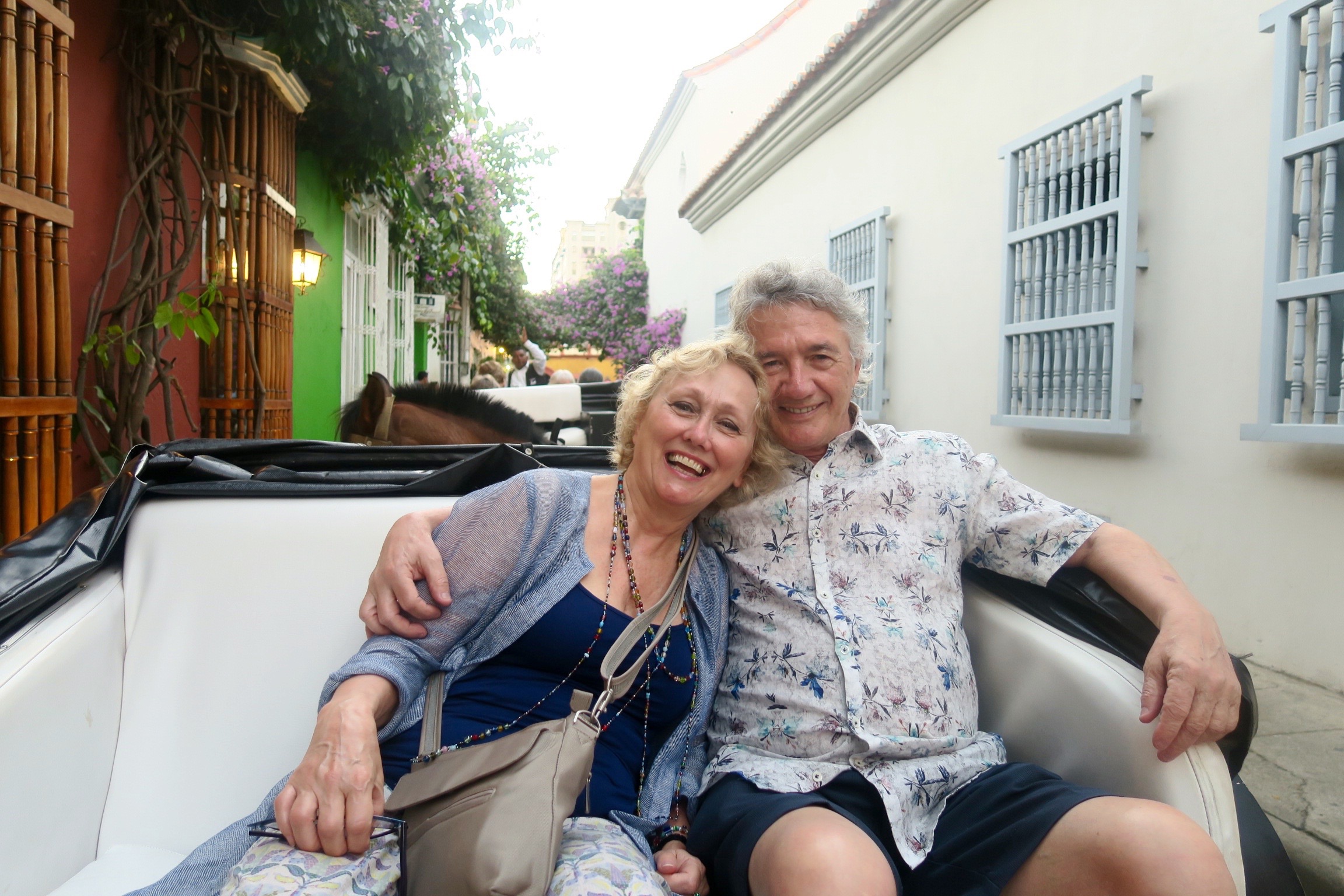Cartagena Part II – What to See and Eat
In my first post on Cartagena I gave a brief outline of the history of the place and a recommendation as to where to stay. In this post I’m going to describe some of the things you’ll want to see, a couple of great places to eat and as promised, how to get rid of a mime. This will be my final specific report from Colombia at the end of what has been an eye opening and frankly unexpectedly wonderful trip to this underrated country. As I’ve come to expect over the past 20 plus years I’ve been traveling with Adventures Abroad, you more than get your money’s worth by getting off the usual tourist beaten path while at the same time not missing out on the ‘must see’ attractions. Colombia’s a bit different that way, in that I suspect most people don’t have a pre-conception of what the ‘must see’ places are. I know I didn’t, other than Cartagena which numerous friends who had visited before me, simply raved about. Turns out they were right. Here’s a few reasons why.
Castillo de San Felipe de Barajas, Cartagena
Coming from a city whose # 1 tourist attraction is a giant fort (Halifax Citadel in case you’re interested) I always like to compare the size of my fort to others when I travel, so naturally the first place I went in Cartagena was the windily named Castillo de San Felipe de Barajas. Just outside the actual city walls this was the principal fortification of Cartagena and the one that the English tried repeatedly to take and repeatedly failed. As forts go, it’s pretty impressive, especially given its history of successfully defending sieges, most notably that of Admiral Vernon in 1741. As we walked up the ramp to the entrance there was this great display of Panama hats on sale for the princely sum of $5 USD, and that was before bargaining.
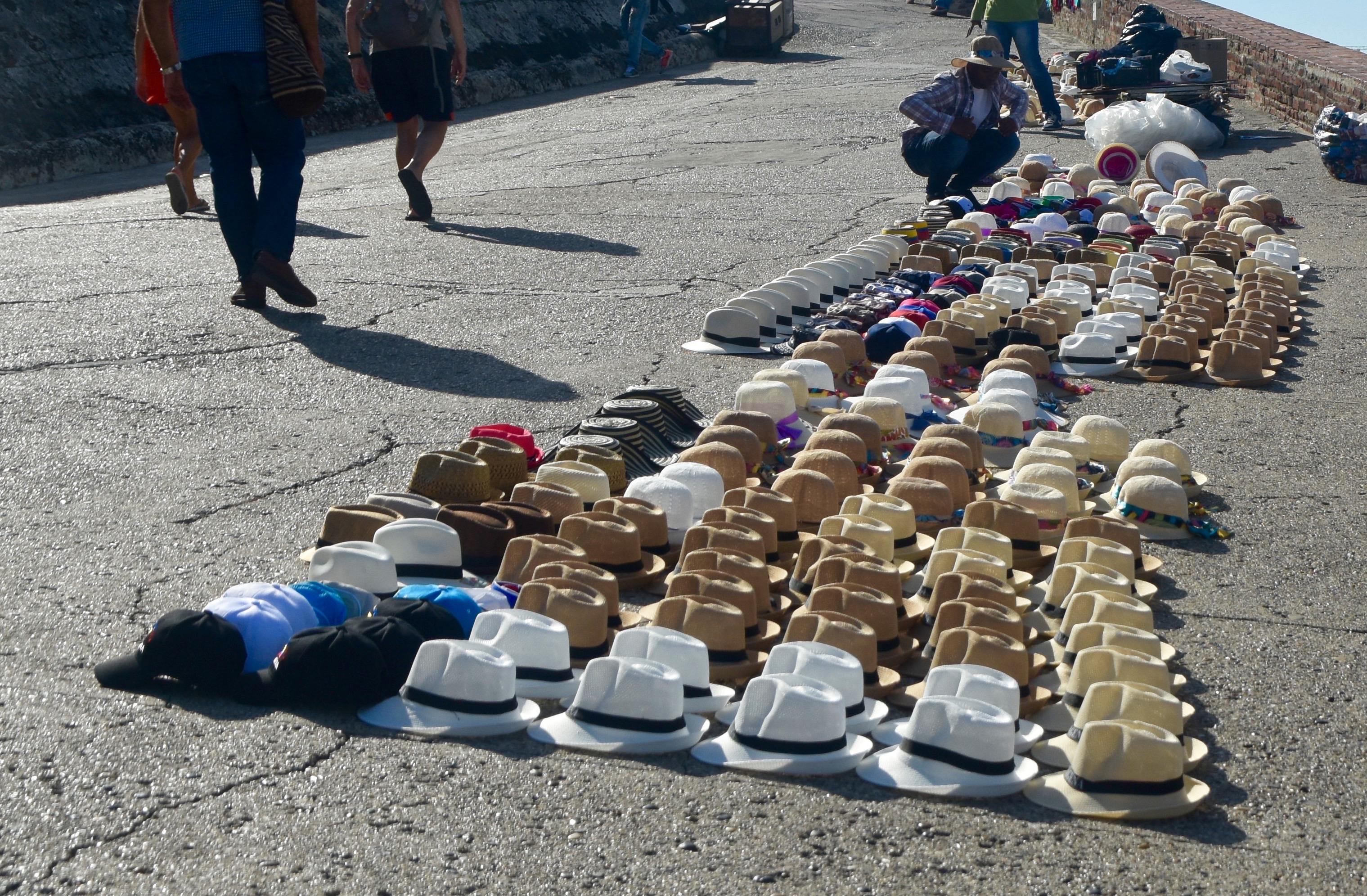
Forts are great to look at, but other than that there’s not much more to them. Here’s Alison barely containing her glee at being here.
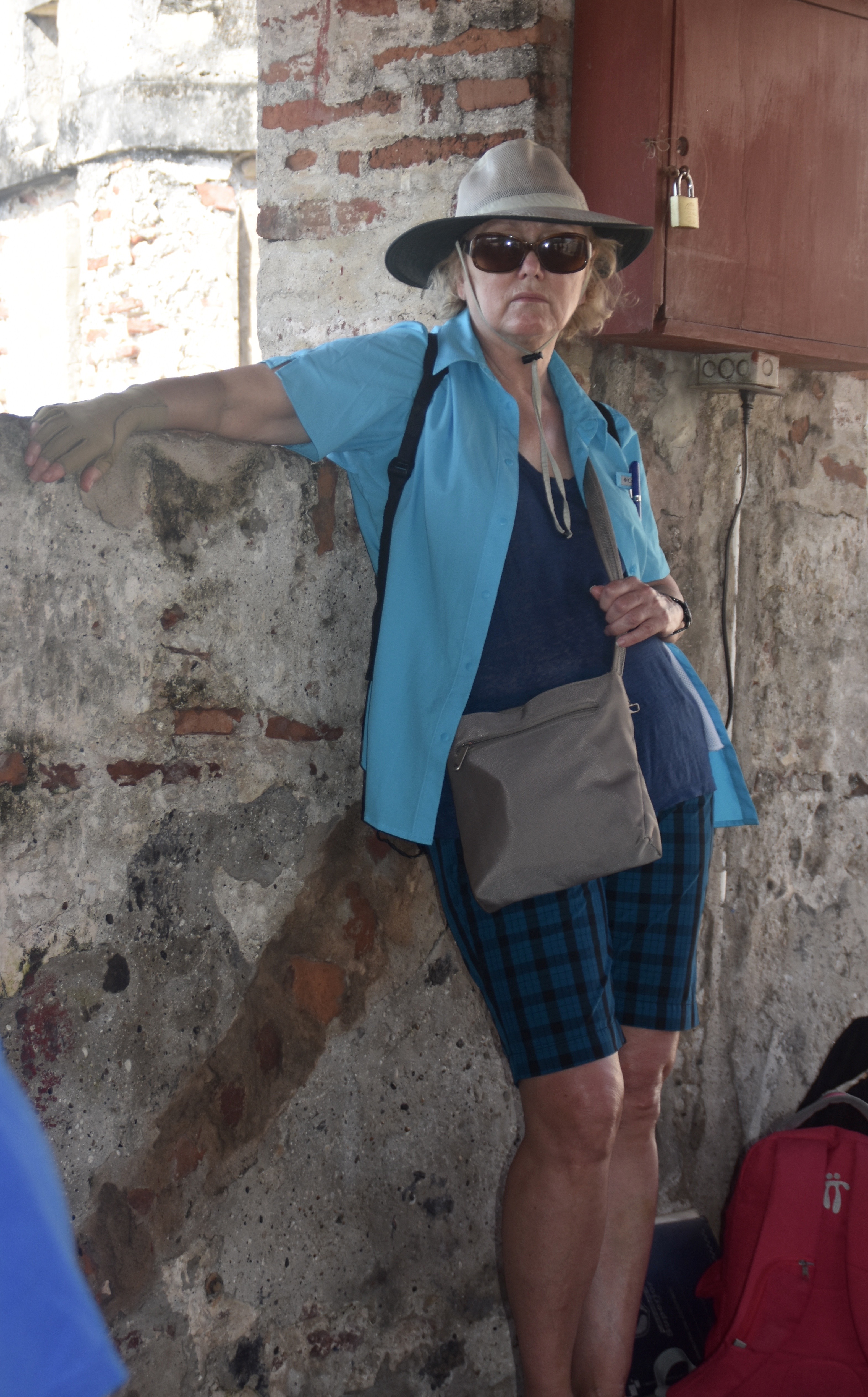
No wait, there’s always the great shot of contemplation by a cannon.
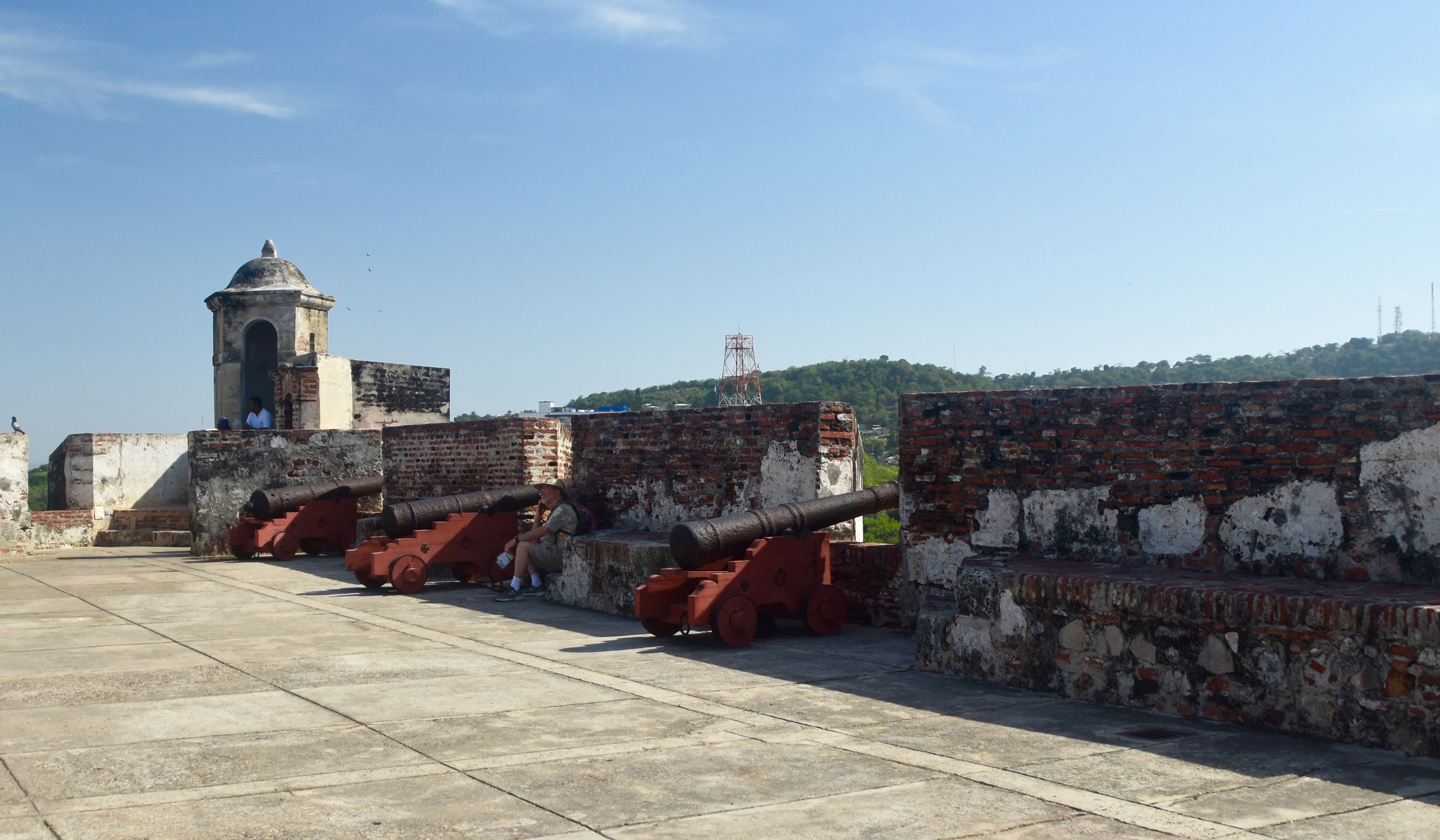
Or the national flag flying triumphantly oer the ramparts.
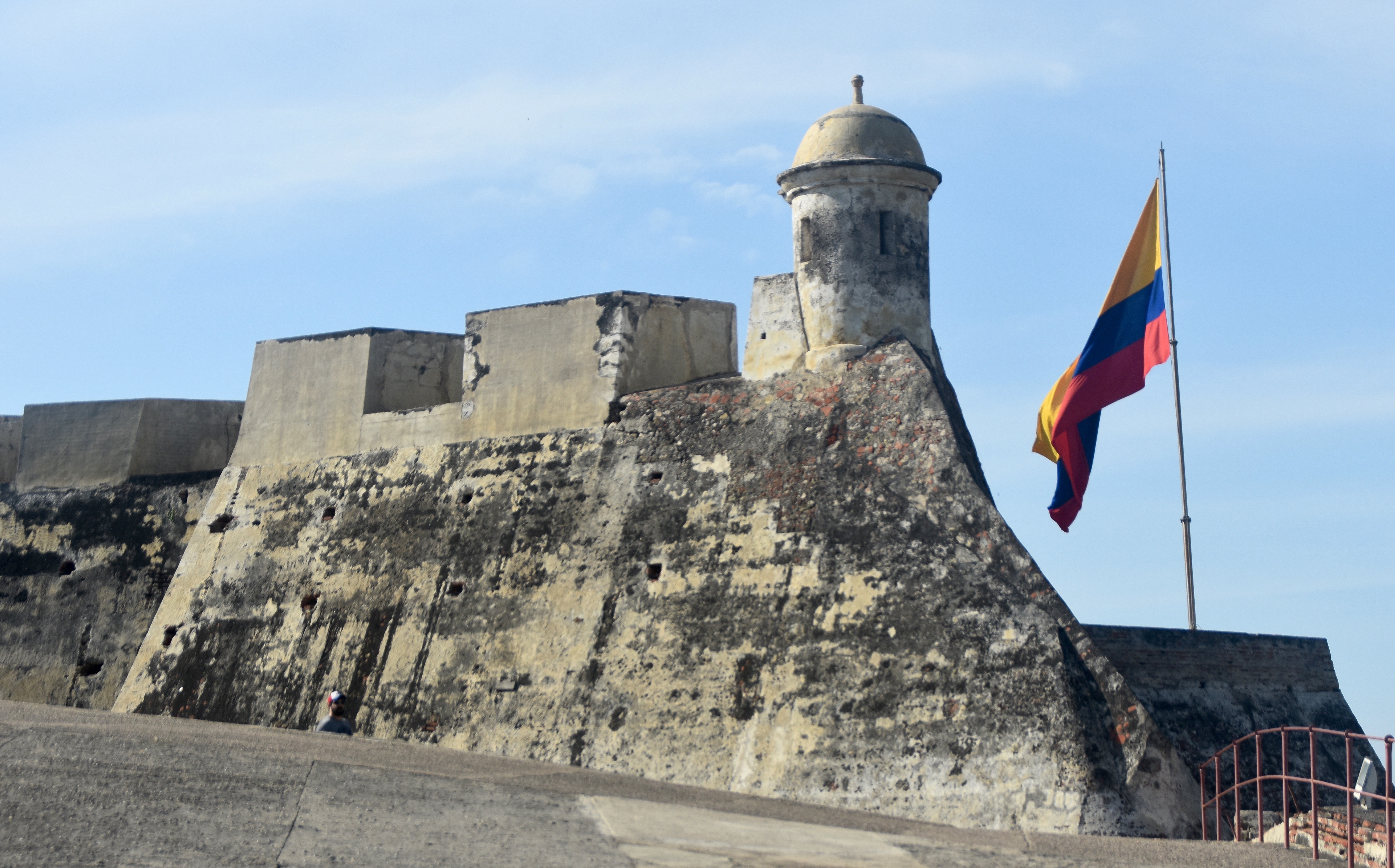
And of course the view. That’s the old city with its two distinct cupolas, but you’d really have no idea how great the city is from this picture which makes it look like there are more high rise buildings than there really are, if that makes any sense.
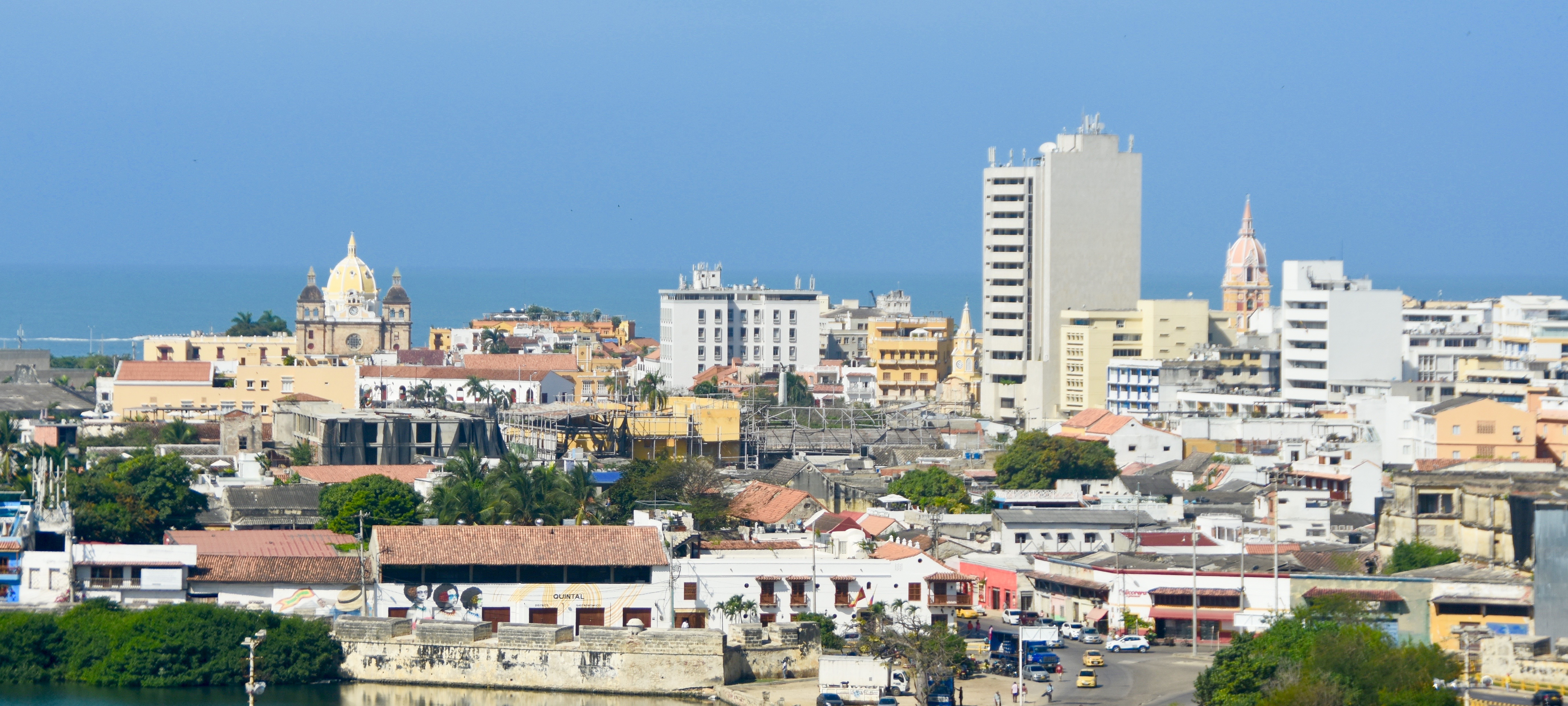
And here is the view of the new city from San Felipe.
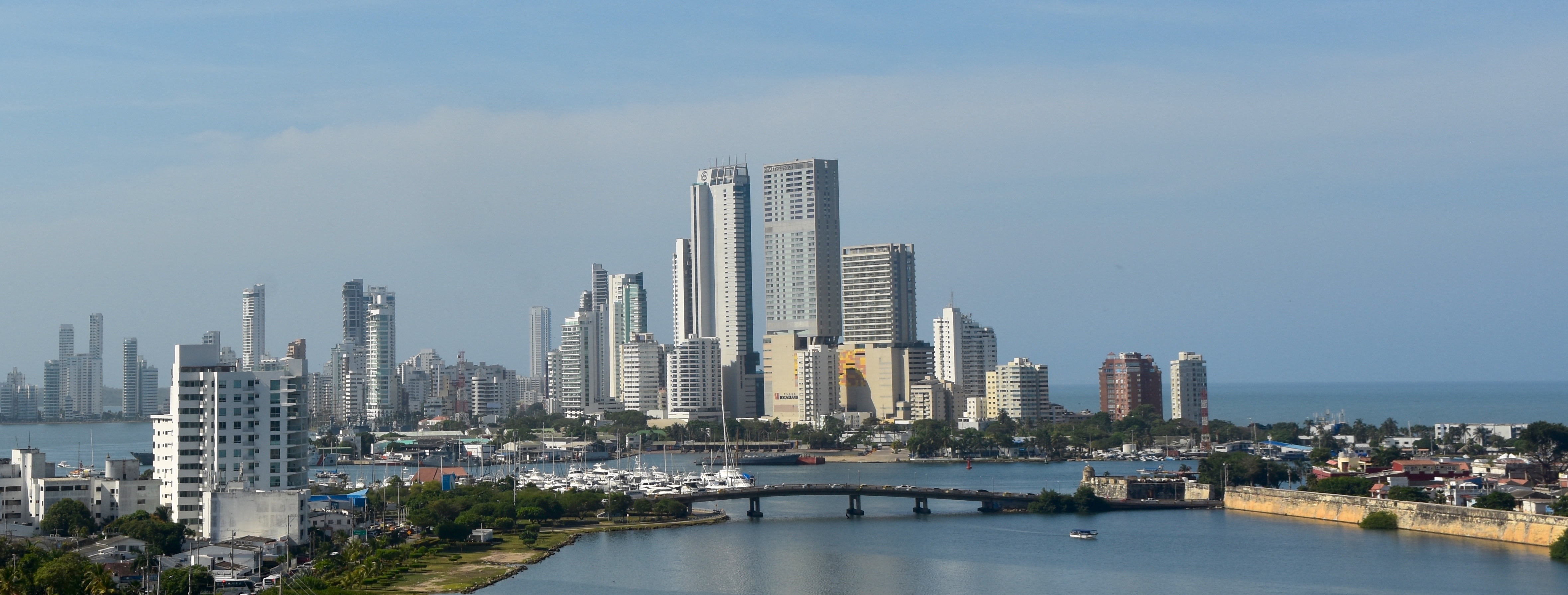
So that’s the fort, now let’s visit a few religious institutions to get a feeling for the role the church played in Cartagena’s history starting with a monastery built with the money from a slave trader.
La Popa
Named not for the guy who lives in Vatican City, but rather because the mountain it sits on just outside Cartagena reminded people of the poop deck of a ship, La Popa monastery dates all the way back to the early 1600’s. It has an absolutely killer view.
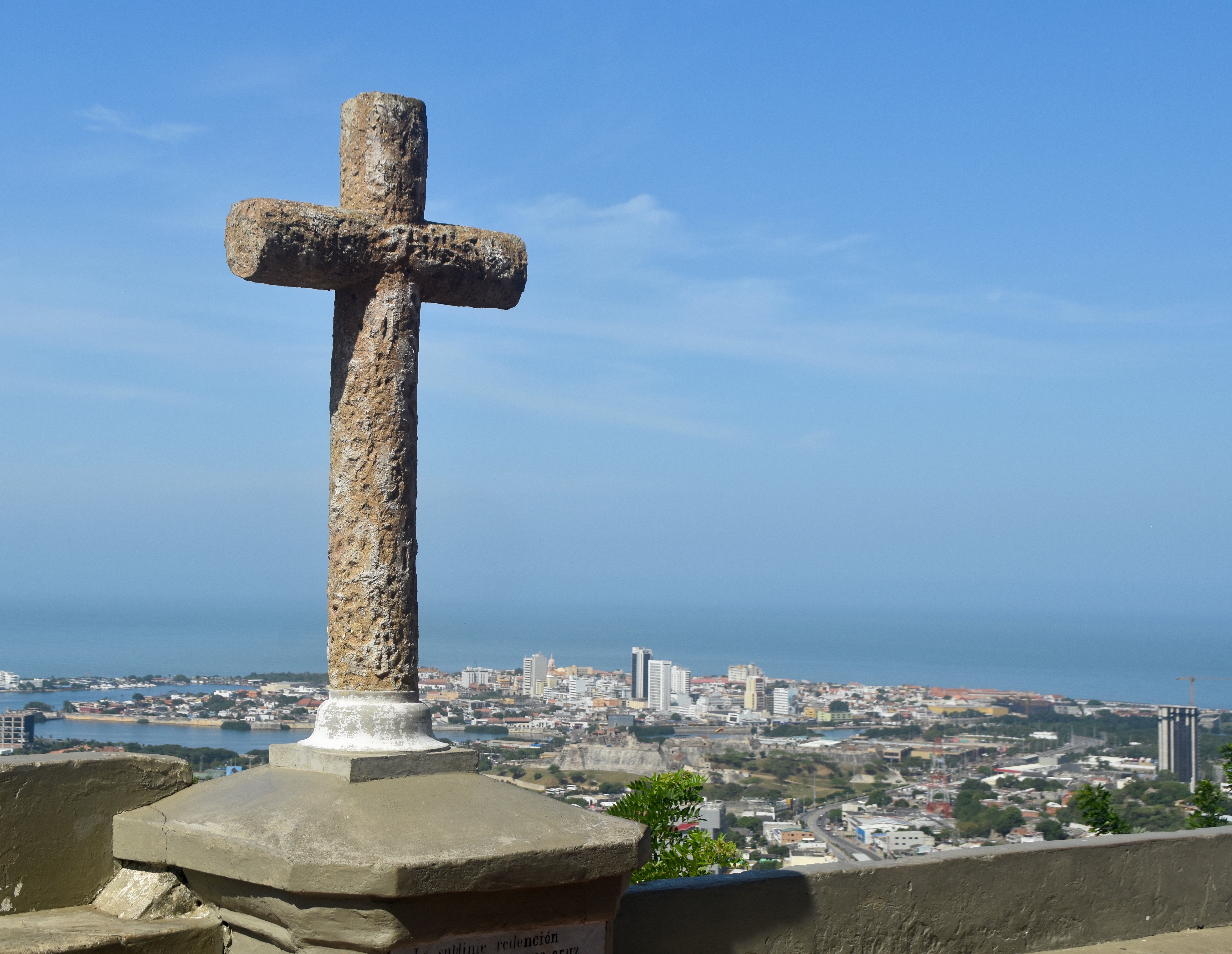
That’s San Felipe Fort from Popa.
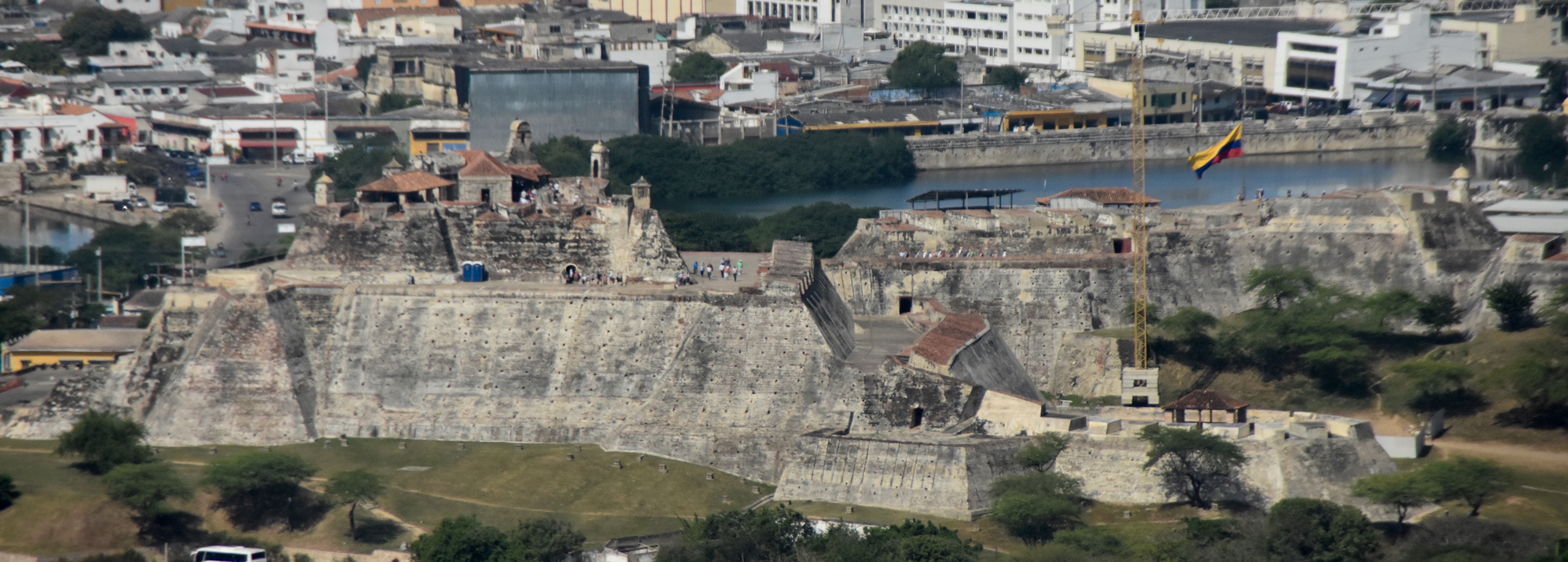
One thing they don’t try to sugar coat at La Popa is exactly how the Catholic church once viewed the aboriginals and the blacks that their professed adherents enslaved. This painting in the monastery pretty well says it all. They were devil worshipers so what’s the harm in making them slaves? Actually a little research reveals that Fray Alonso Paredes, the guy who founded the monastery, claimed to have found just this scene going on when he climbed to the top of La Popa. Naturally he toppled the goat idol and replaced it with a cross. The blacks and aboriginals continued their obeisances without missing a stroke.
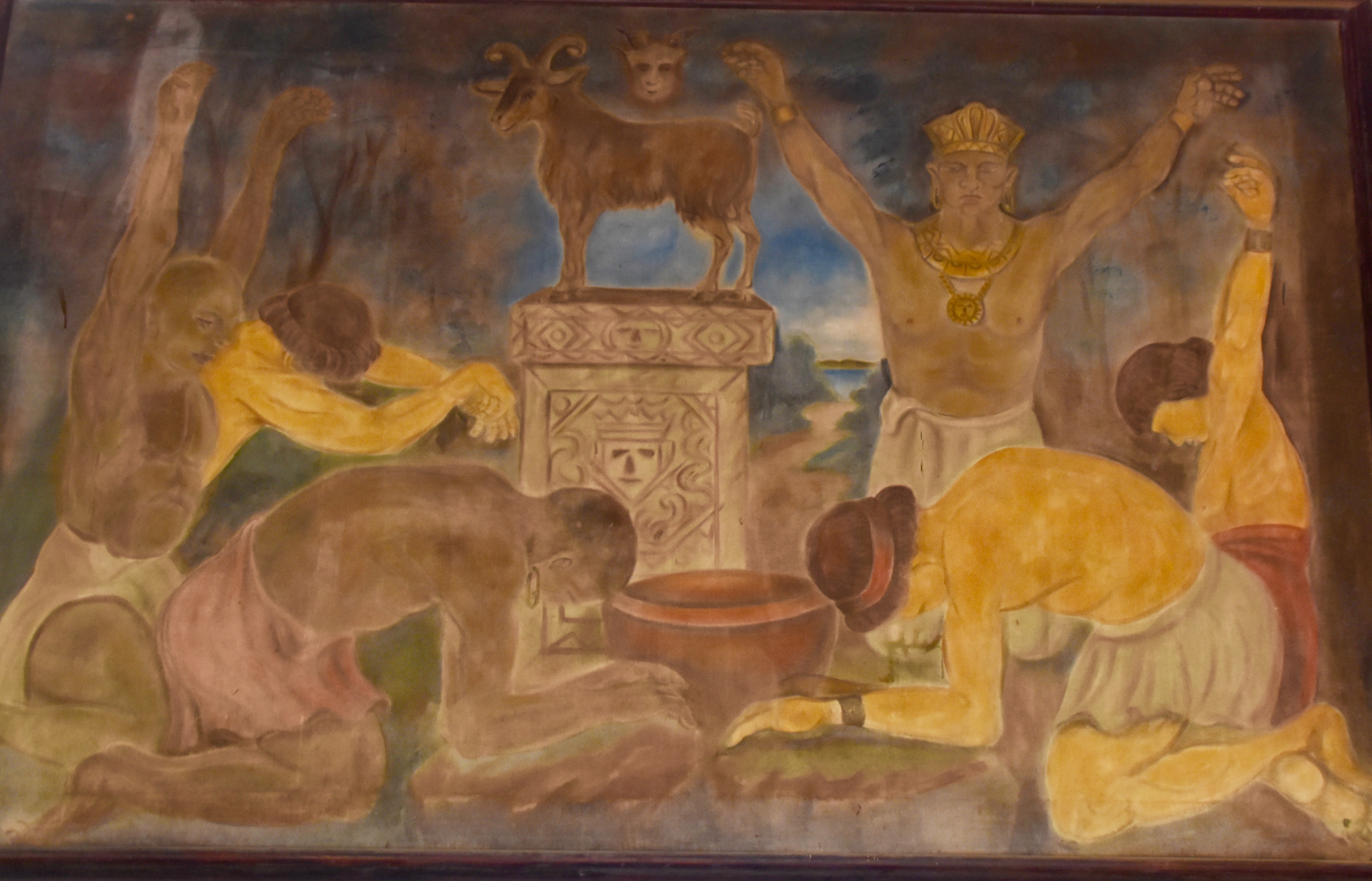
Or maybe he just made that up. His reward for converting the heathens was the old spear through the thorax.
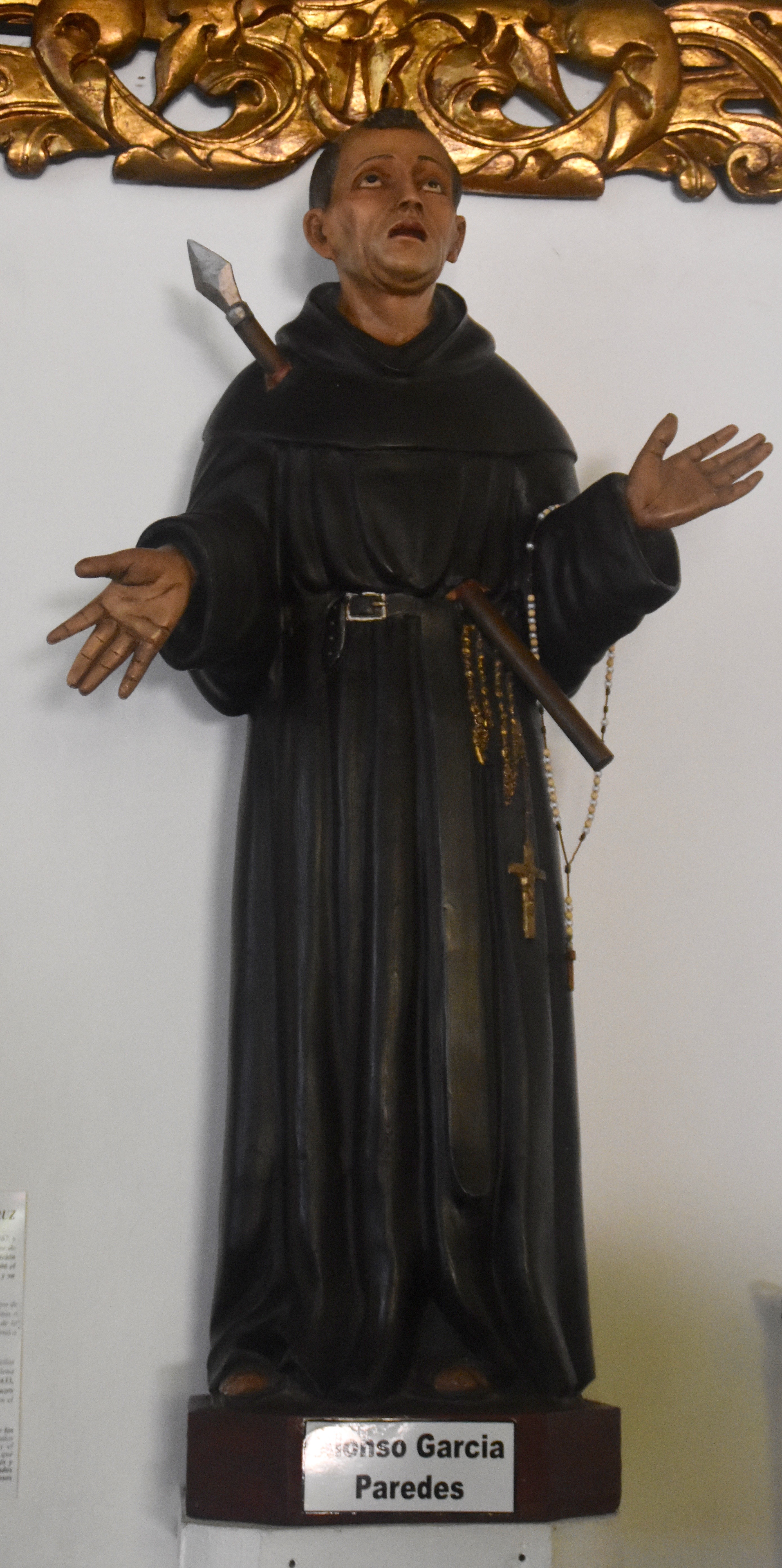
This ostentatious altar was bought over from Italy by a slave trader anxious to buy his way out of the hell he so deservedly belonged in. I hope it didn’t work.
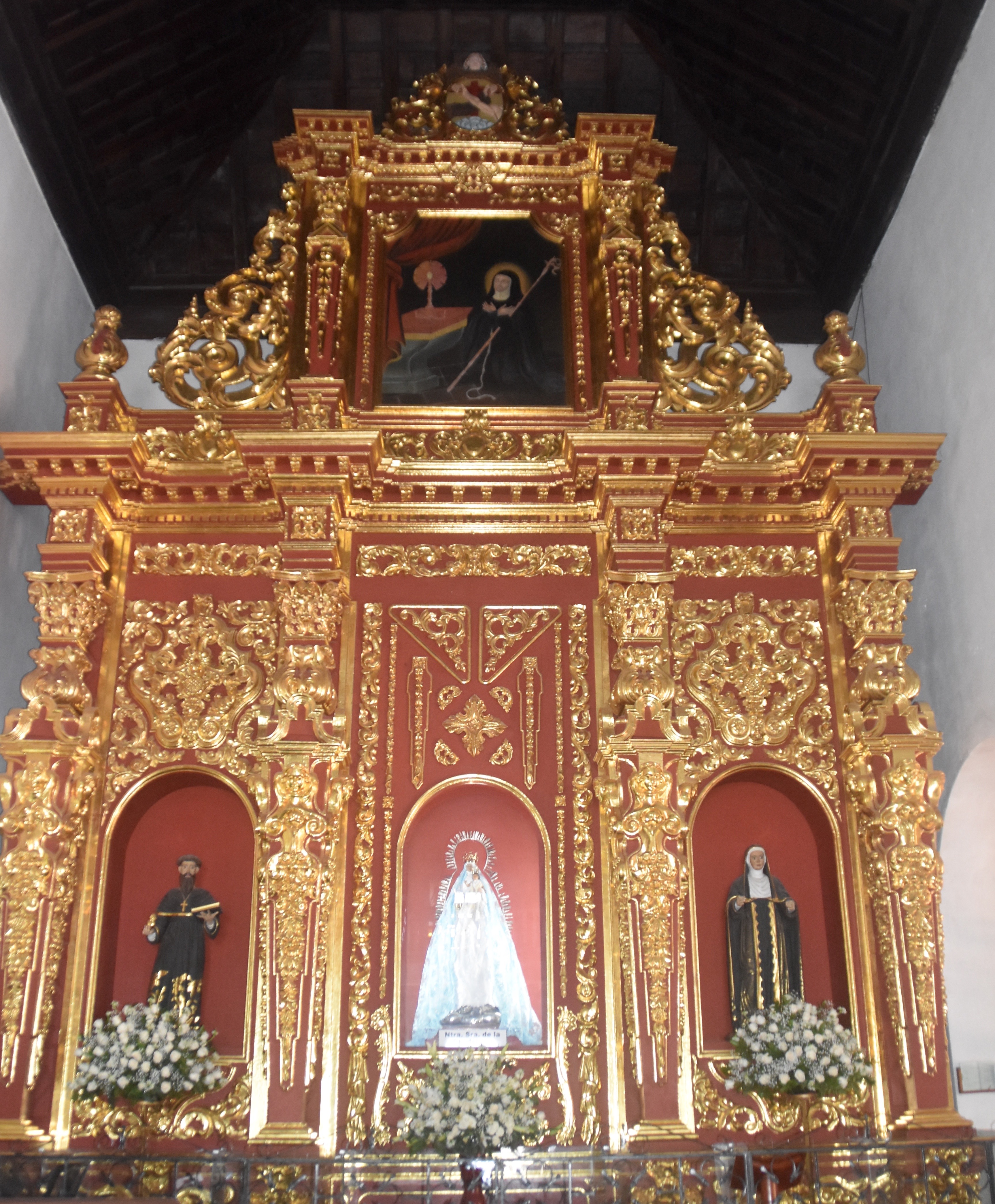
San Pedro Claver, Cartagena
Peter Claver was a much nicer person than Alonso Paredes as rather than blast the slaves for practising their native religions, he sought to free them. For his lifelong and apparently truly Christian adherence to The Golden Rule, he was given a saint hood and had a great church built in his honour so his earthly remains could be put on display for all to see. The Capilla or Sanctuary of San Pedro Claver is the most prominent of the older buildings in Cartagena and probably the most visited. Its yellow dome might be considered the signature sight in the city. It is certainly beautiful in both the rising and setting sun light that bathes the city twice a day.
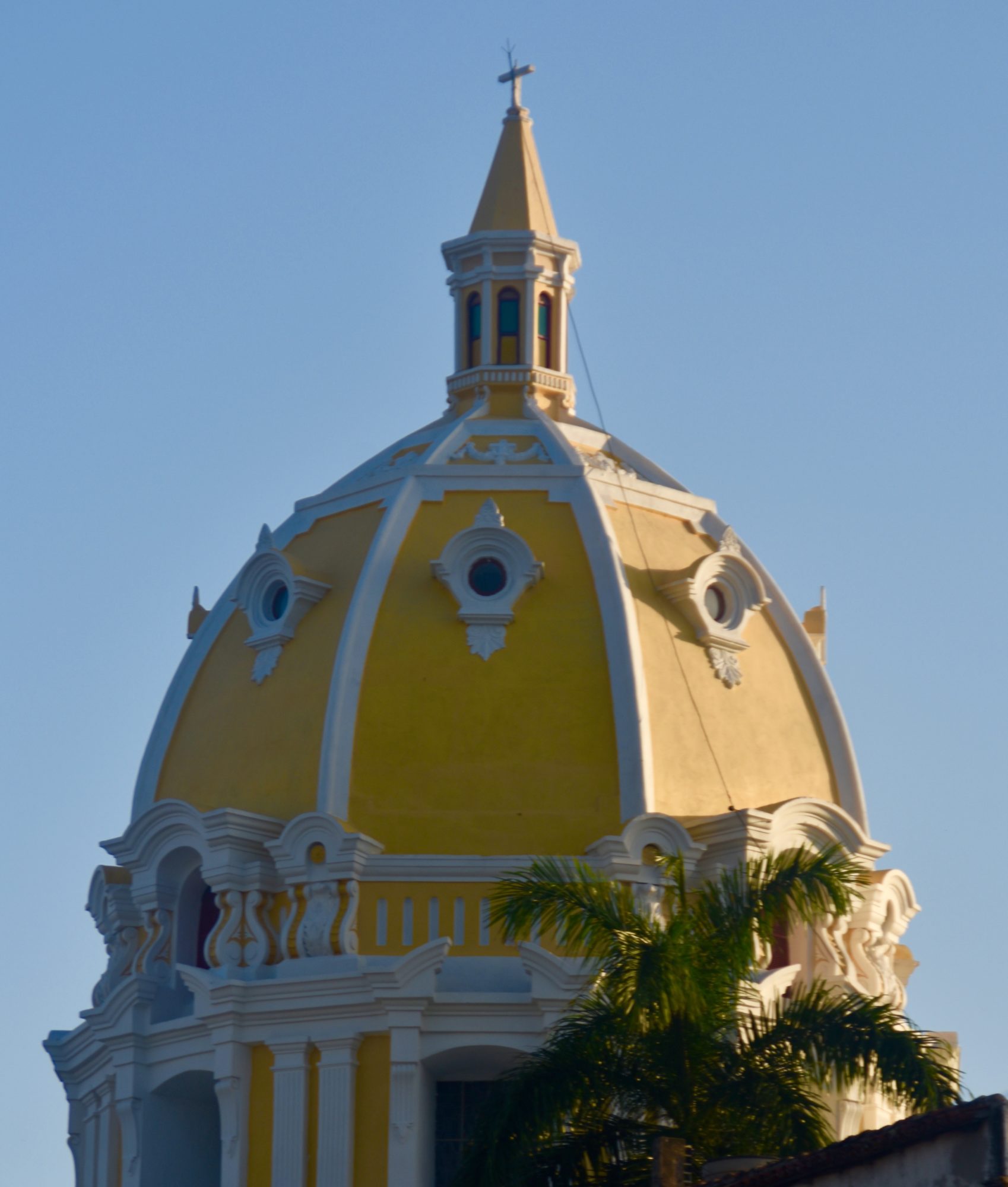
Inside is almost as nice with this view of the dome interior especially noteworthy.
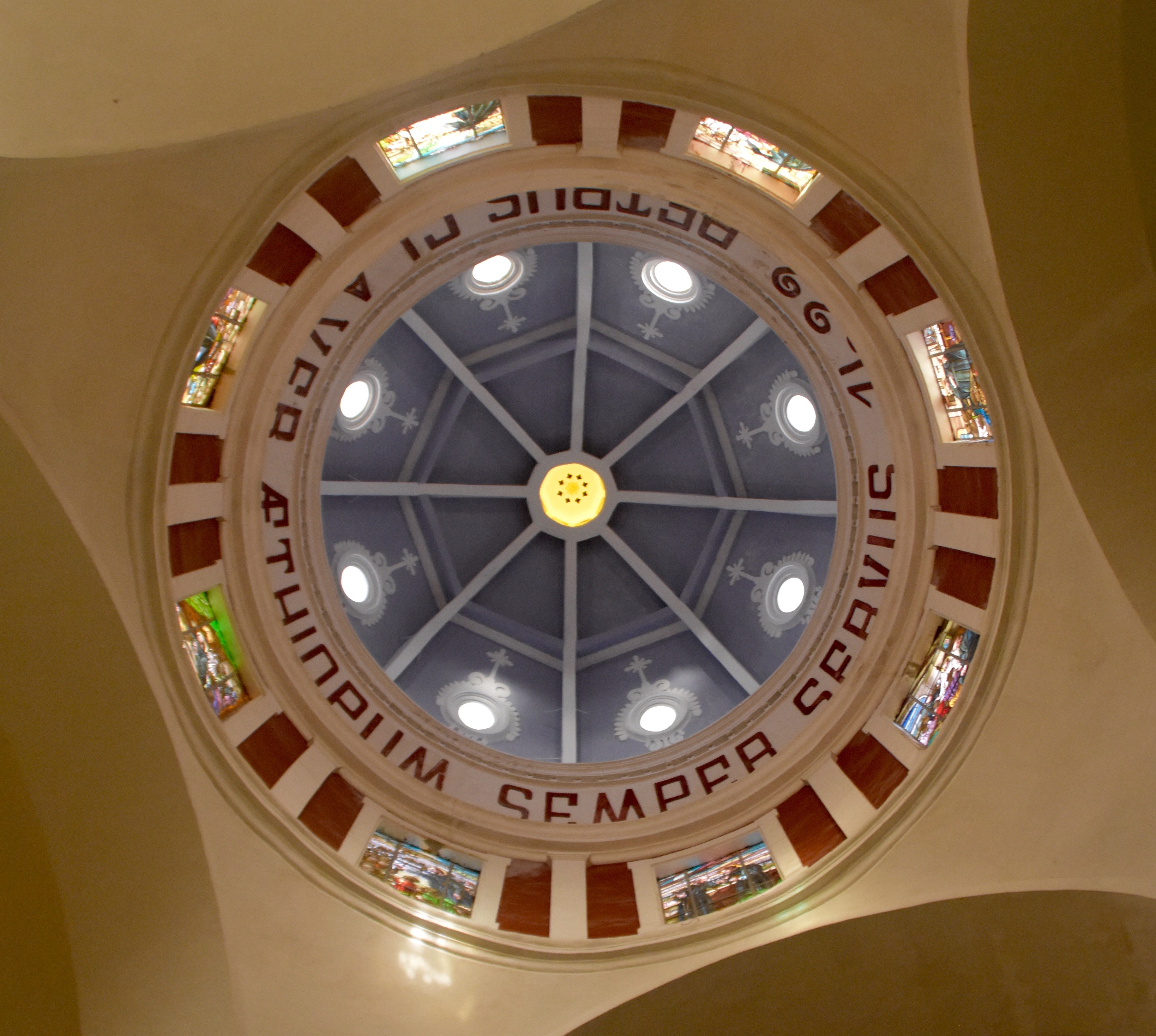
There are a few statues of Peter around including this one which I found irritatingly patronizing, but maybe that’s just me. As much as I like to look for the dark side of religious figures, I really couldn’t find anything bad about this guy.
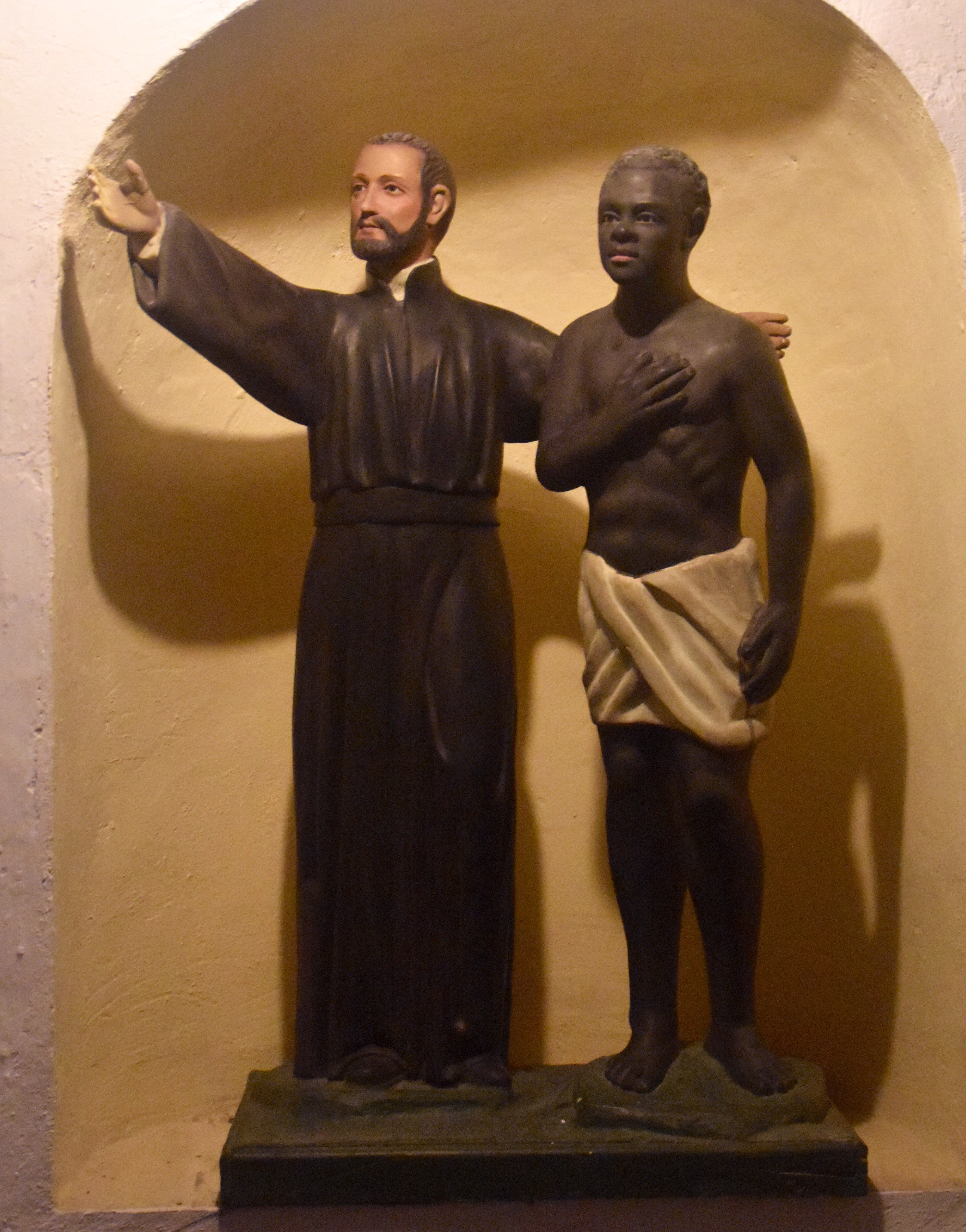
And then of course who needs a statute when you’ve got the real deal? Here are Peter’s corporeal remains.
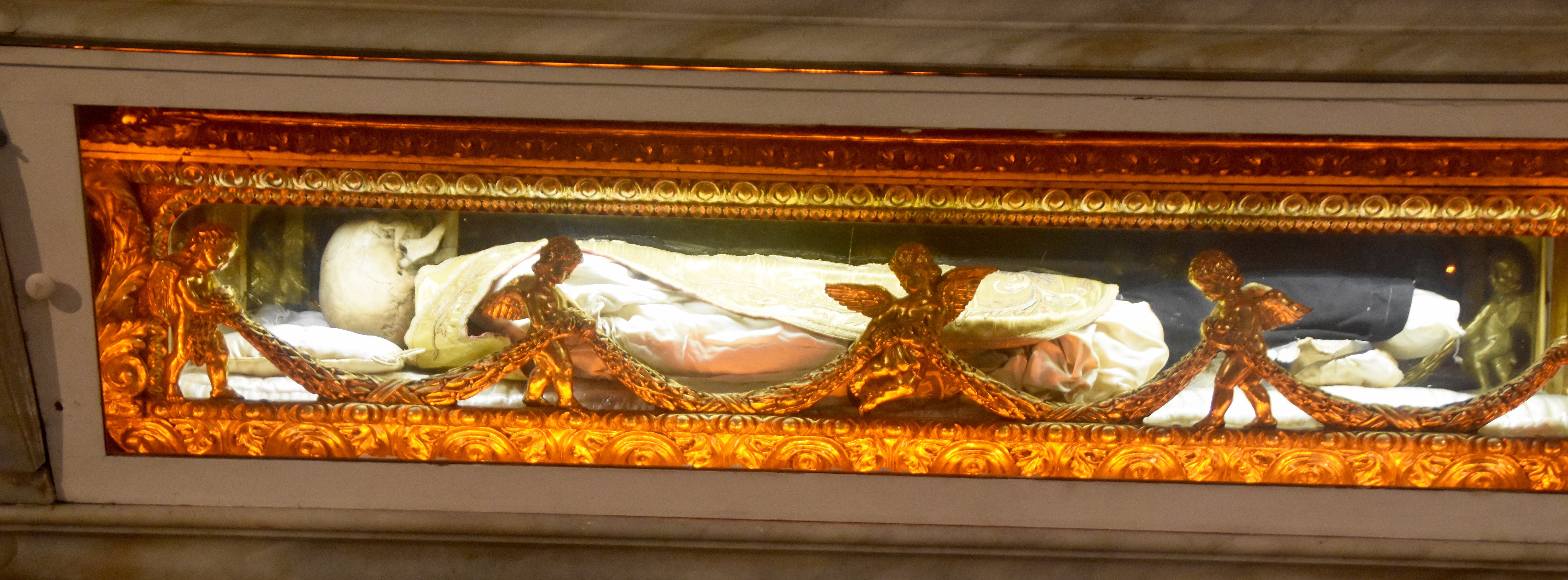
There is also a museum, art gallery, cloisters and Peter Claver’s very modest personal quarters as well as these bells that were rung to celebrate the Colombian Declaration of Independence on July 20, 1810. As noted in my first post on Cartagena, that didn’t work out too well and it took eleven years and thousands of deaths (far more than in the American Revolution) to finally achieve real independence. At least they didn’t crack.
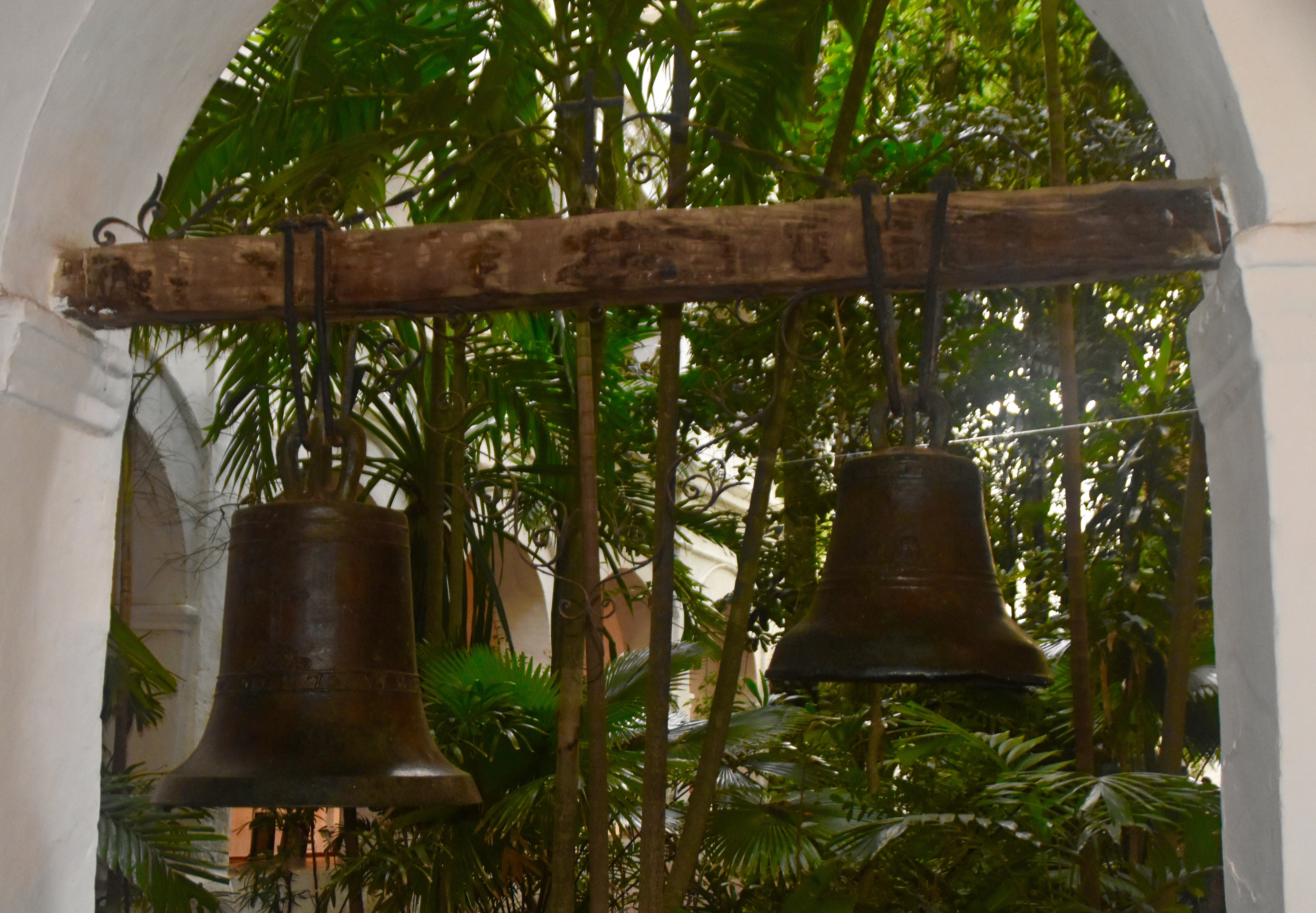
Inquisition Museum, Cartagena
OK, we’ve seen the bad cop act – Alonso Paredes at La Popa and the good cop act at San Pedro Claver. Now we are going to come face to face with true human depravity on a level that would make a Gestapo member look like a boy scout and all in the name of God. I’m a pretty good student of history, but like the hapless saps in the Monty Python skits, I was not expecting the Spanish Inquisition. Yet, here they were, for over two hundred years the Torture/Death division practised their dark arts behind the walls of the building Alison is about to enter. I was reminded of the sign over the door to hell in Dante’s Inferno – Abandon hope all ye who enter here.
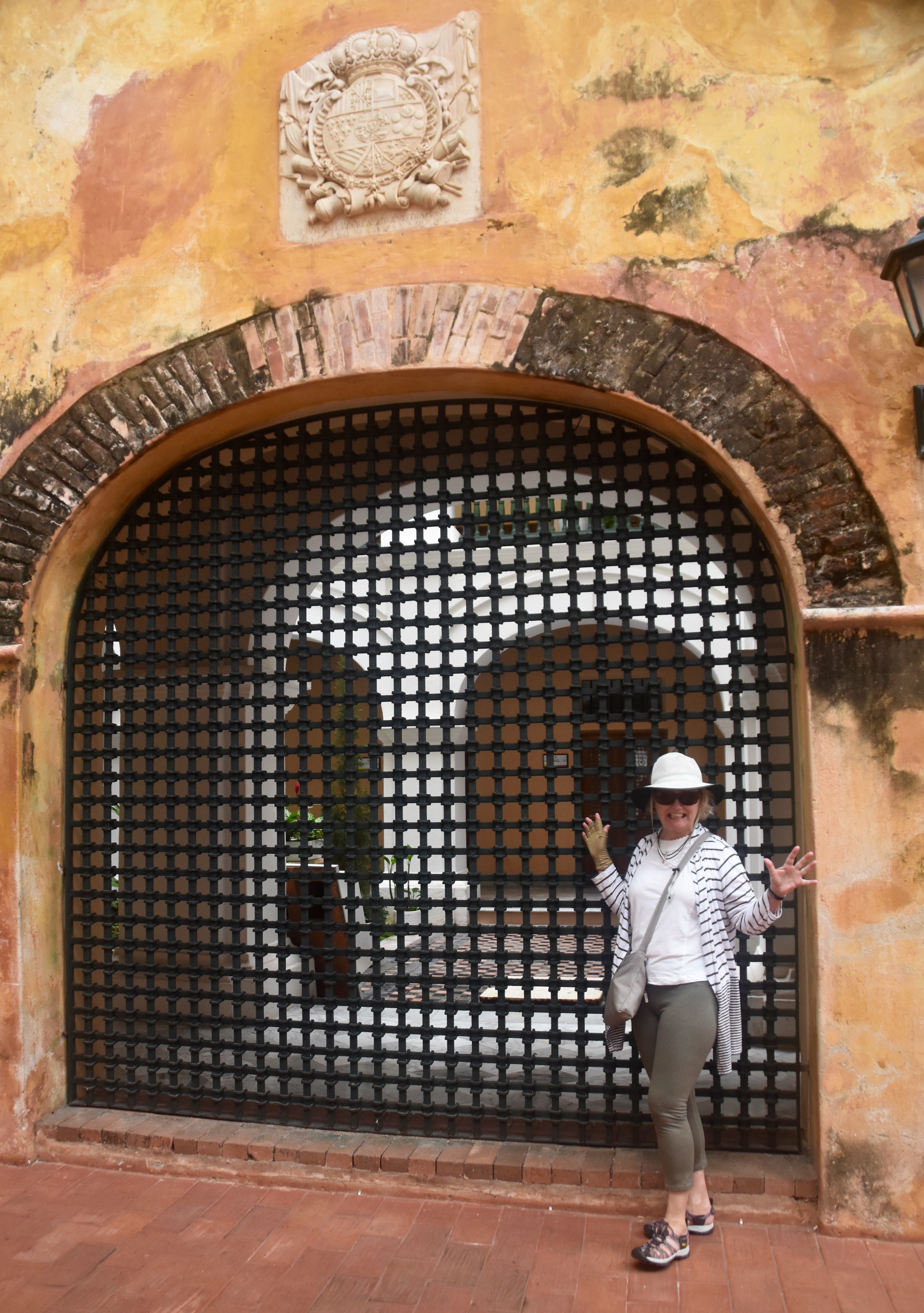
The bottom floor of what is actually a beautiful building is dedicated to the facts of the Spanish Inquisition in Colombia and most tellingly by the instruments of torture. Some of them are so perverse that only someone who was a complete psycho could put them to use. I’ll just show a few, but trust me two is all you need to realize why the practitioners of death and torture in God’s name are considered among the most depraved in history.
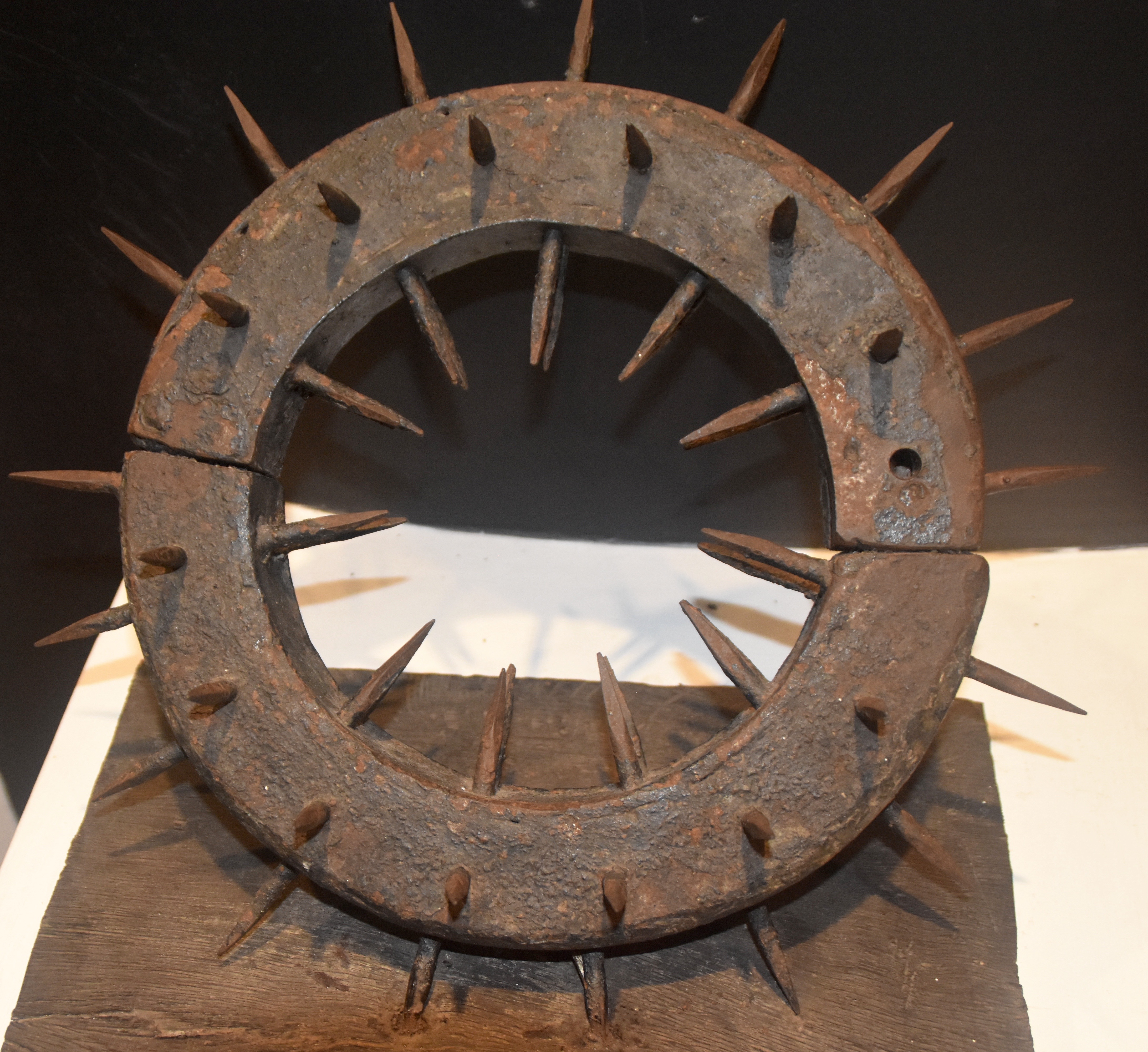
This is a grotesque parody of Jesus’ Crown of Thorns. Made out of iron it weighs a ton and you can guess what it would do the person coronated with it.
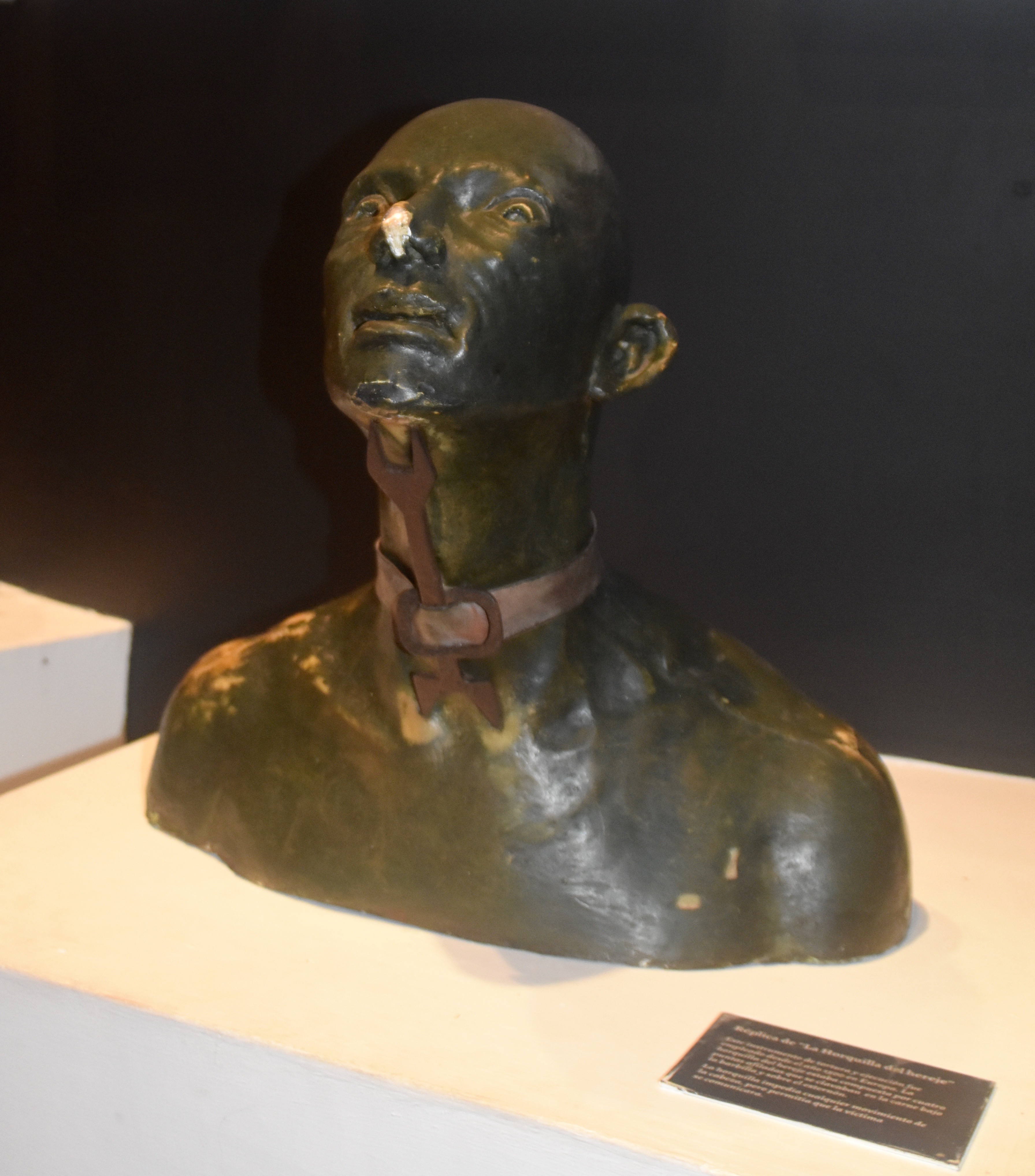
The simplicity of this device is what makes it so terrible. It’s called the Heretic’s Fork and was used on blasphemers. With this in place the person couldn’t talk – no more blaspheming. They also couldn’t sleep as the moment the head fell forward the tines would gouge their throat and keep them awake. BTW when Pope Francis came for a visit a few years back these torture instruments were taken off display so as not to offend his sensibilities.
There is an open courtyard that is a welcome relief from the dark interior until you see this. Invented very late in the Inquisition period and put to great use during the Reign of Terror in France, apparently this more ‘humane’ method of execution was used during the final days of that heinous institution.
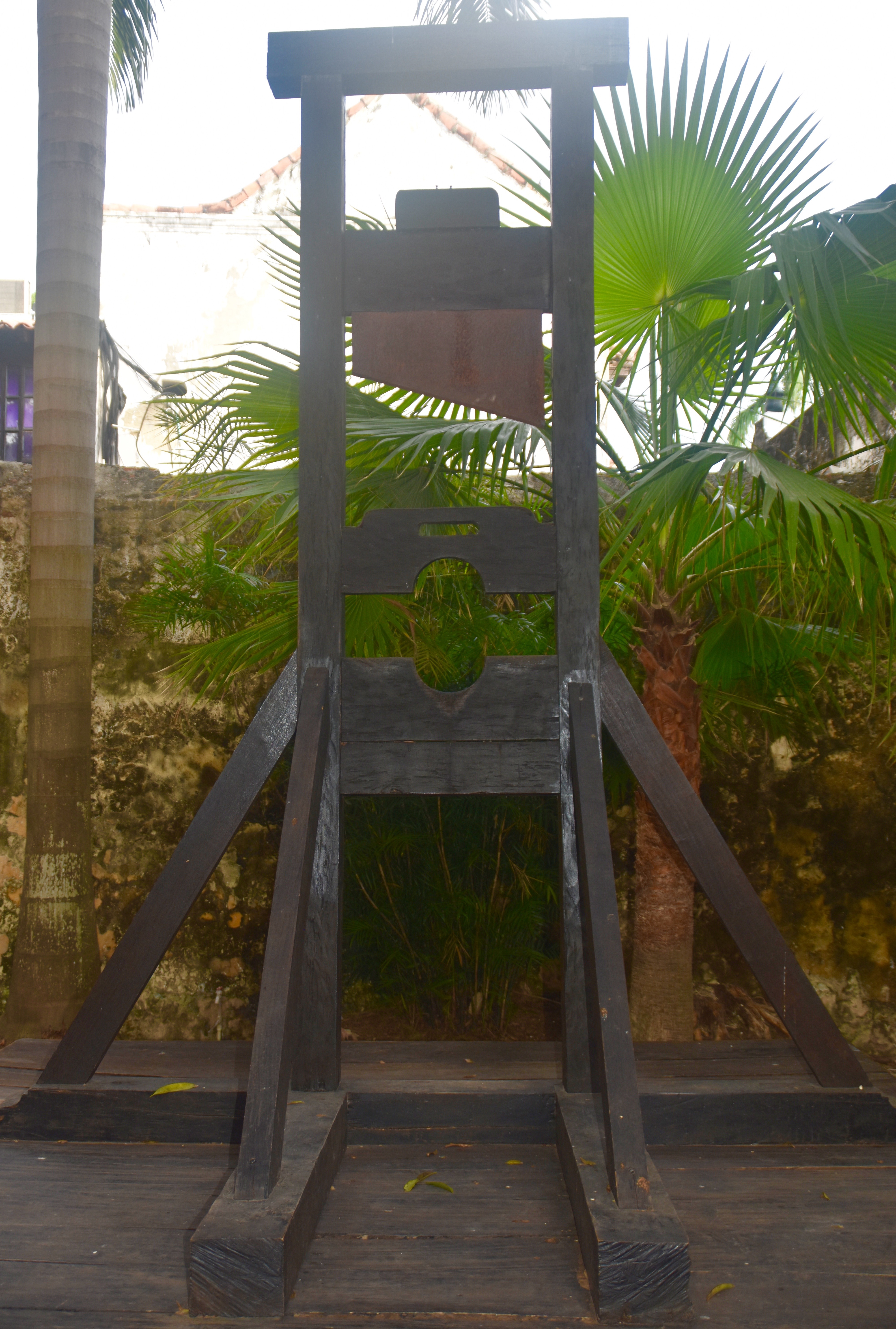
By this time our group’s practical joker (there’s always one), Mickey Rothstein has seen enough and tries to put an end to it.
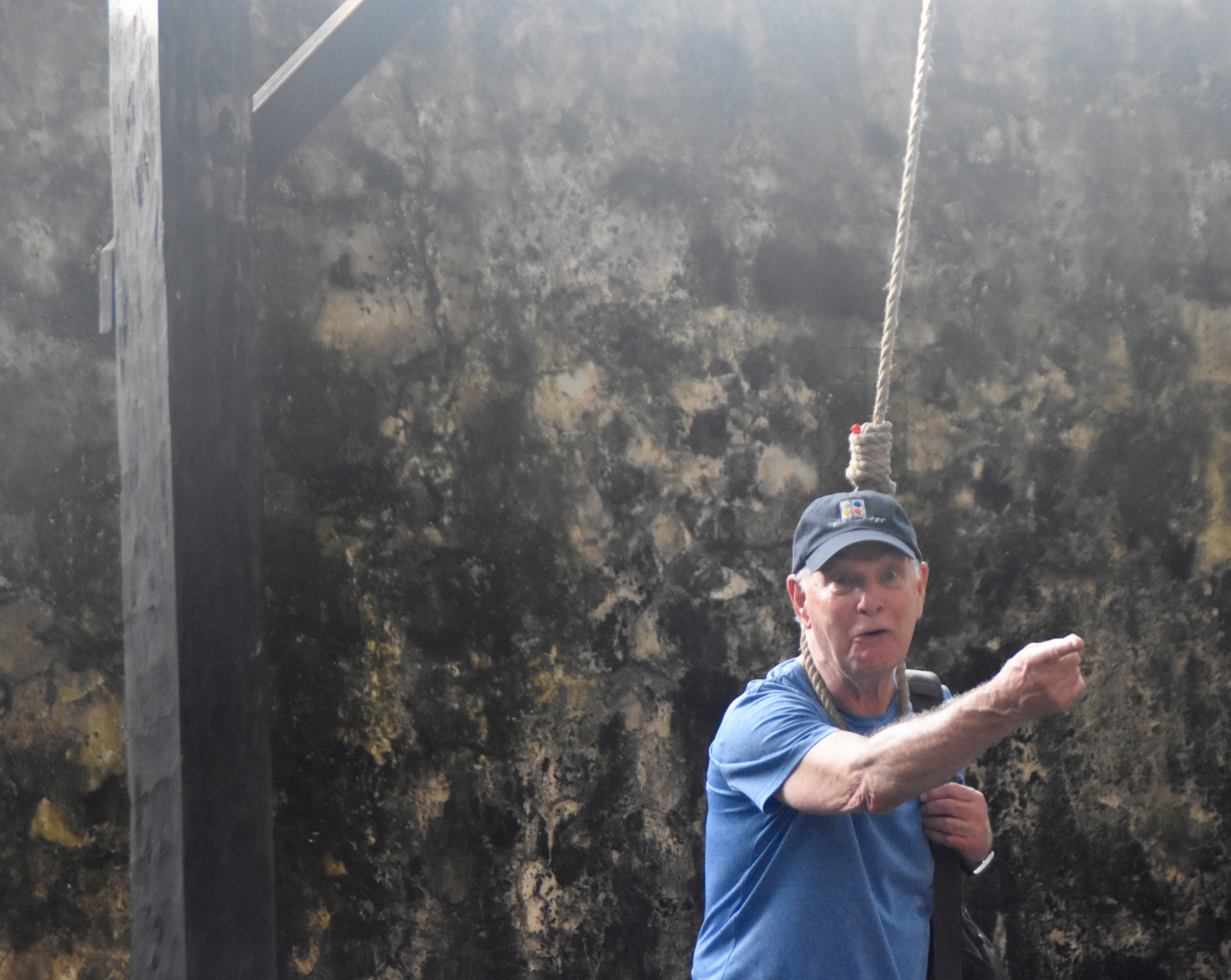
Luckily he doesn’t succeed.
So that’s a quick look at some of what I would call Cartagena’s hard assets – places you check off on your list of places to visit in the city. Wait, what about those famous walls? Well actually they are a bit of a disappointment. Unlike Rhodes, Dubrovnik or Avila, Spain, you cannot walk around the old city by just staying on the walls. In many places they are just walls and not ramparts. There are certainly places you can walk and I would encourage anyone to do it, particularly on the side facing the Caribbean, but don’t come to Cartagena imagining that the walls are the big attraction, there not.
What for me was the big attraction about Cartagena was not the walls or the buildings, but the intangibles. The little things that collectively make up a greater whole. Here are a few examples.
Looking down narrow streets and seeing the spire of the Cathedral of St. Catherine.
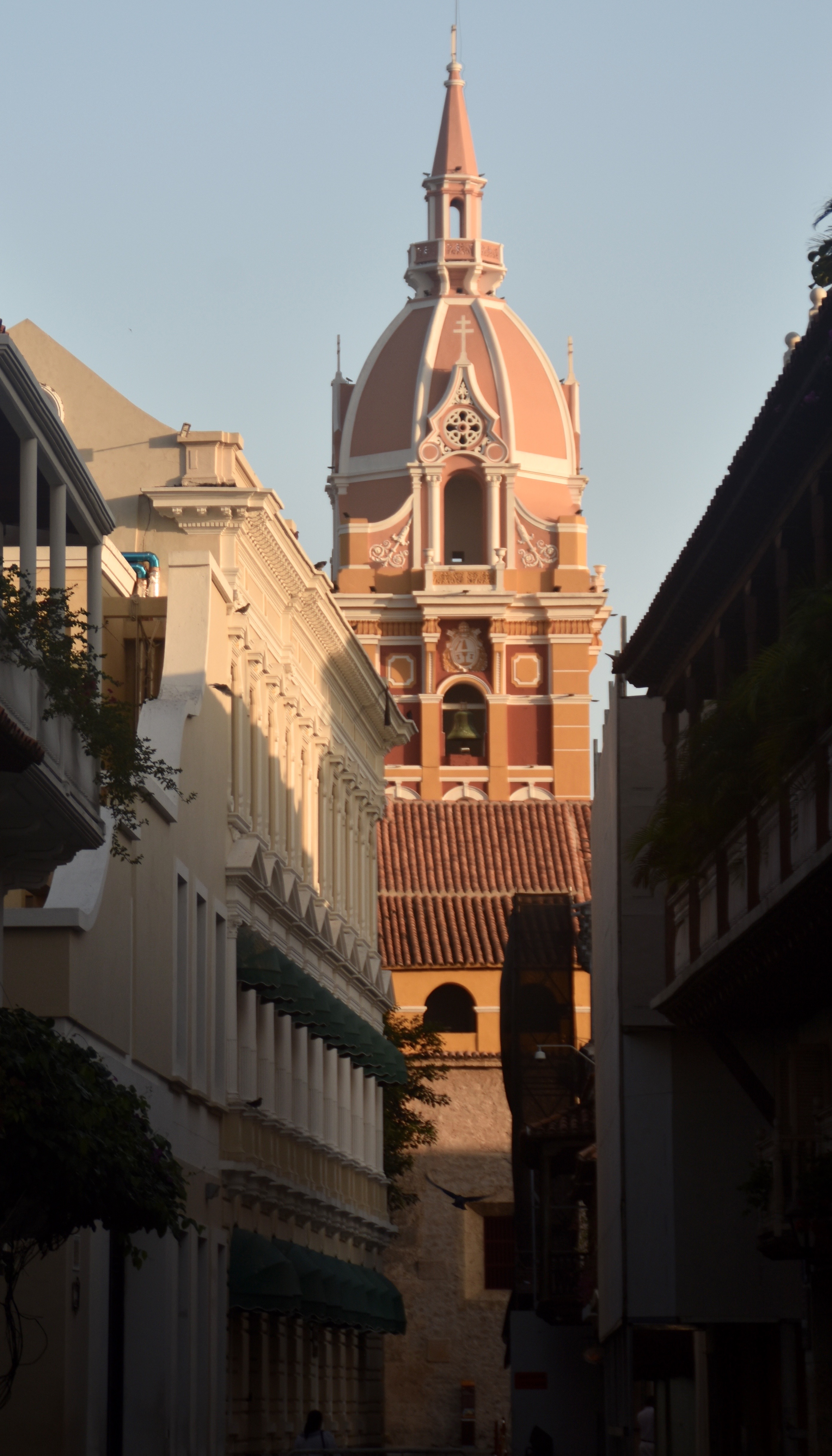
The flowered balconies.
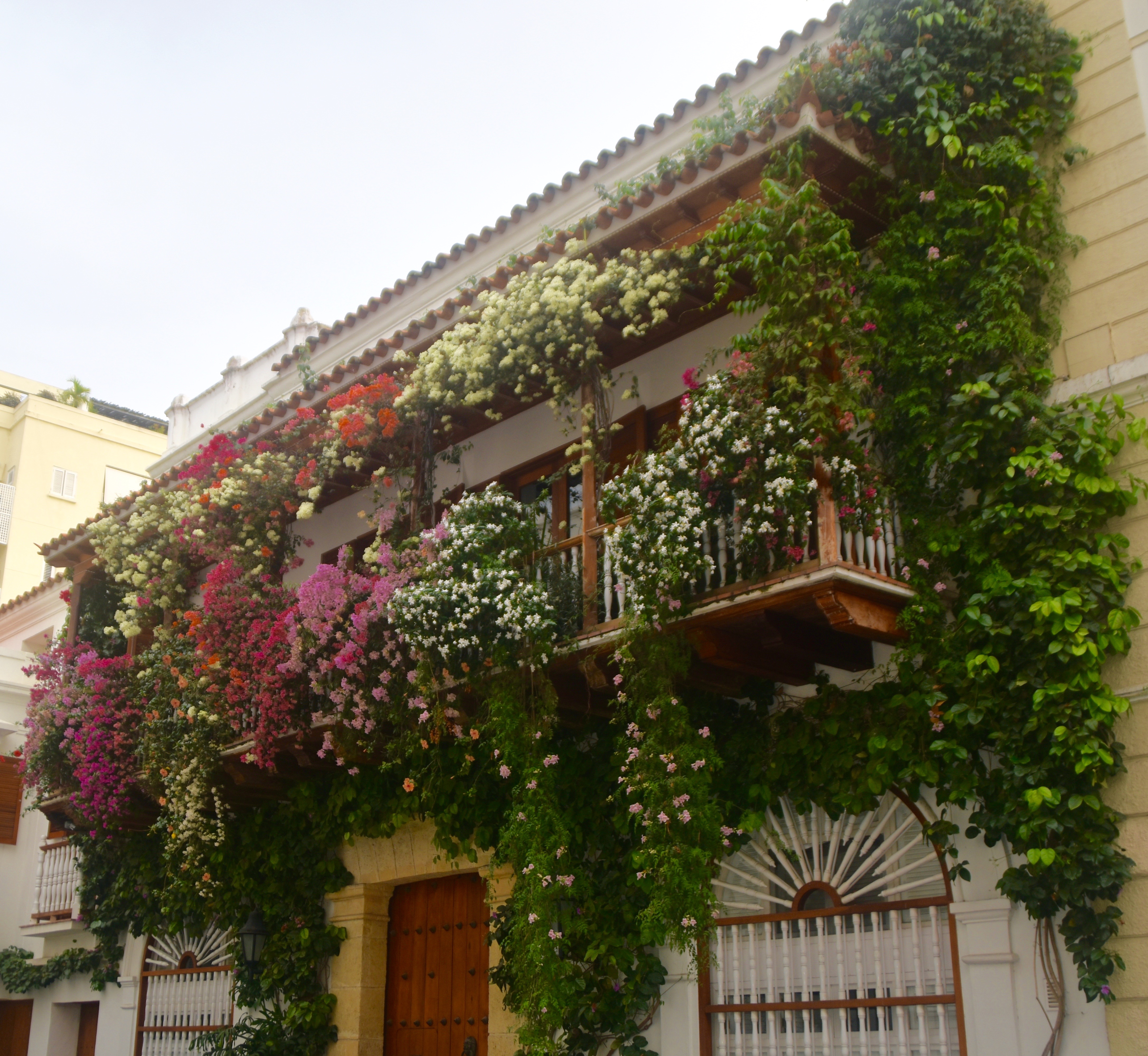
Cartagena has a lot of public art, some serious like this these statues marking the spot where independence was proclaimed in 1810. Also note the symbolic hummingbird in the background.
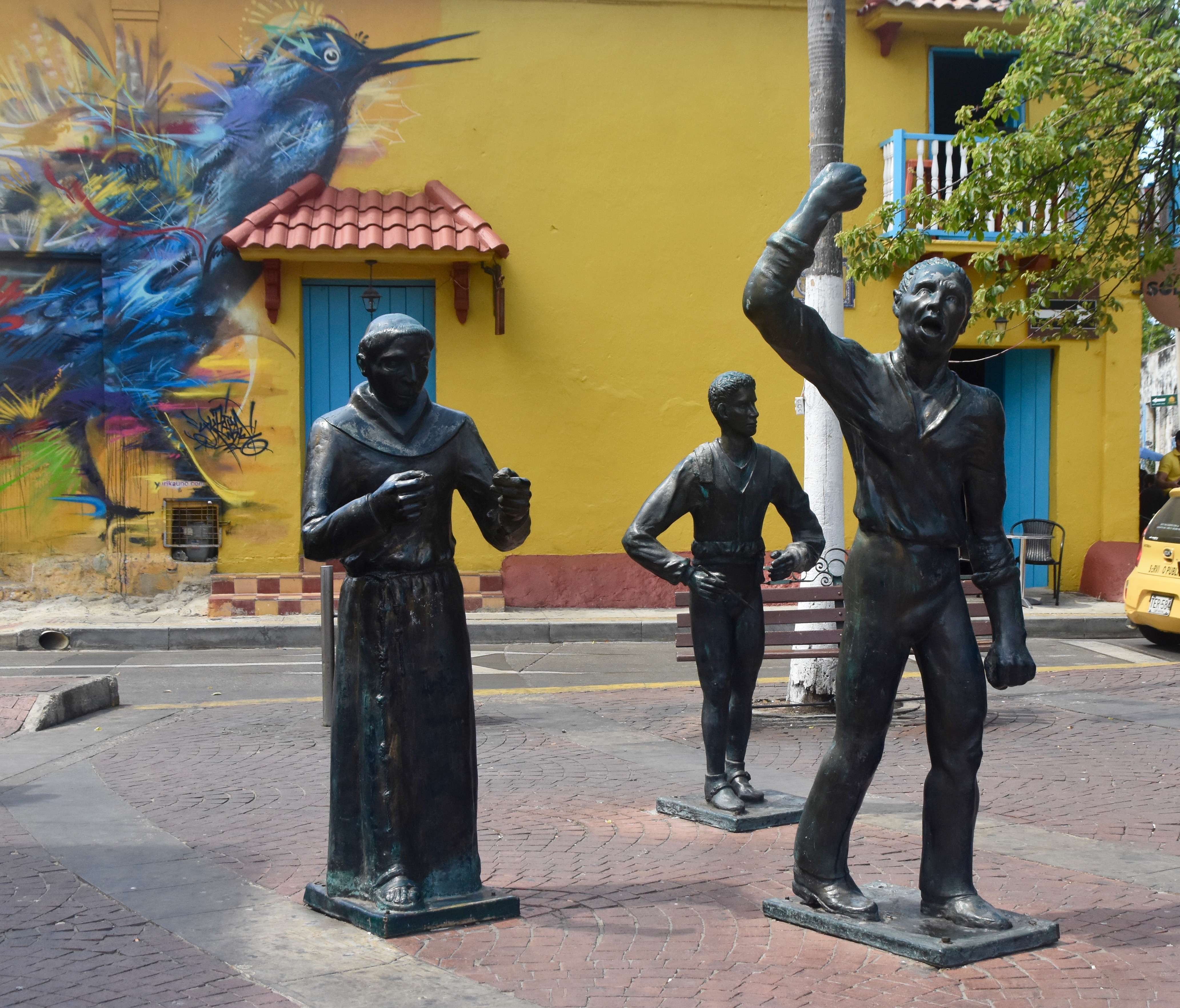
However, most of the public art is whimsical. Like these.
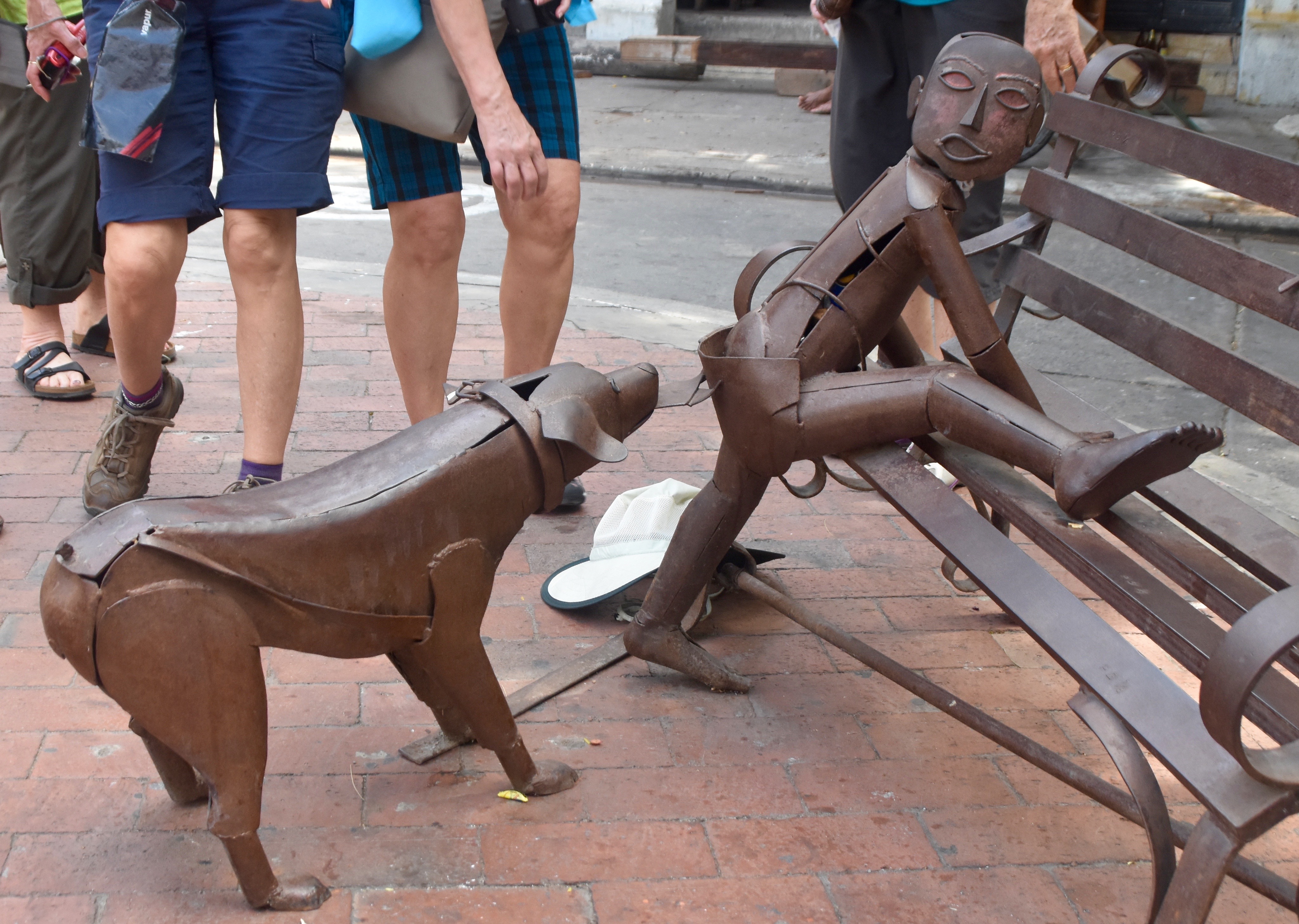
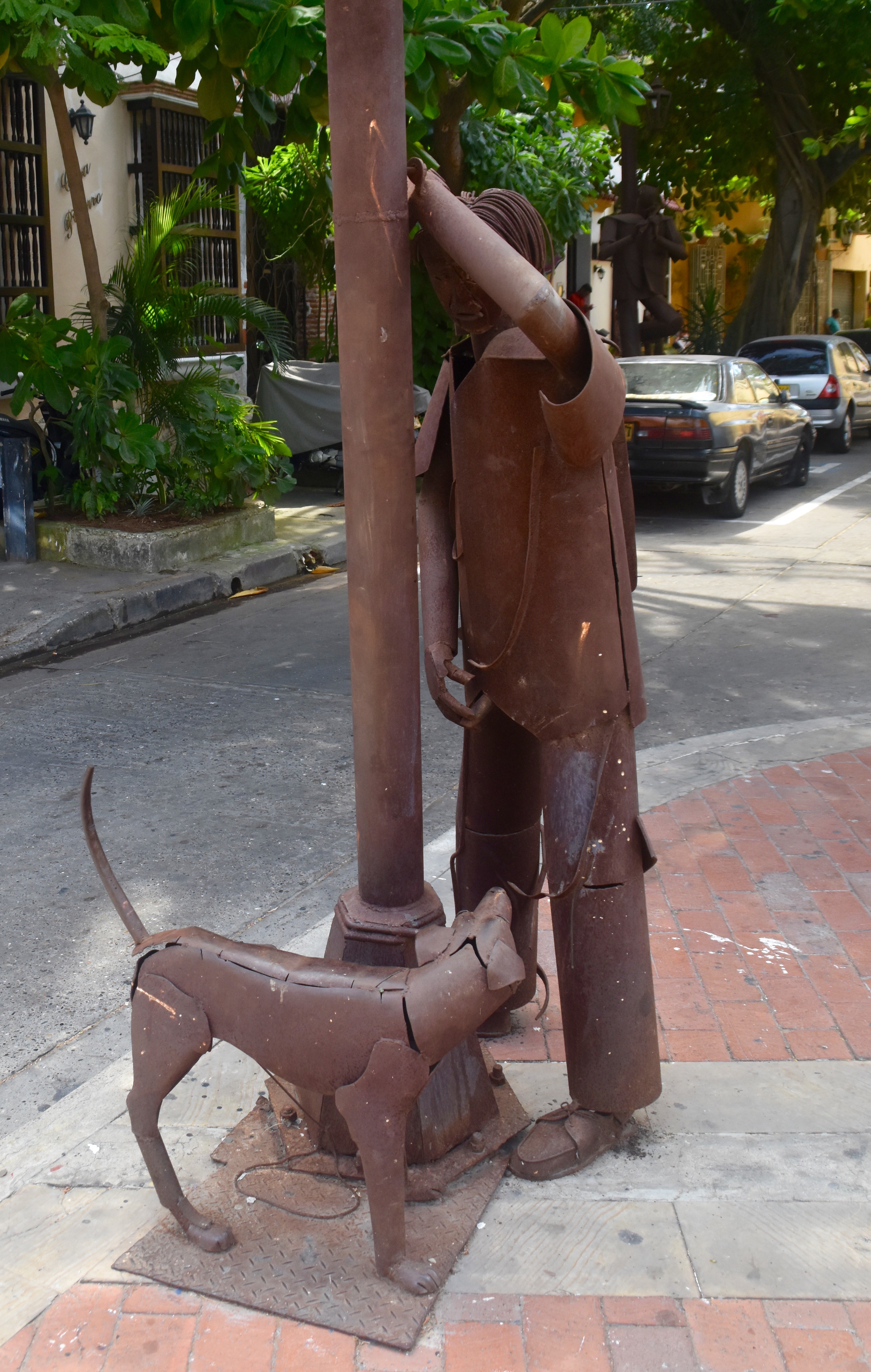
Because its a tourist city Cartagena has the usual bunch of dressed up characters who are generally an annoying distraction, however I did like looking down at this chess match between Spiderman and an older gent with the Pink Panther looking on.
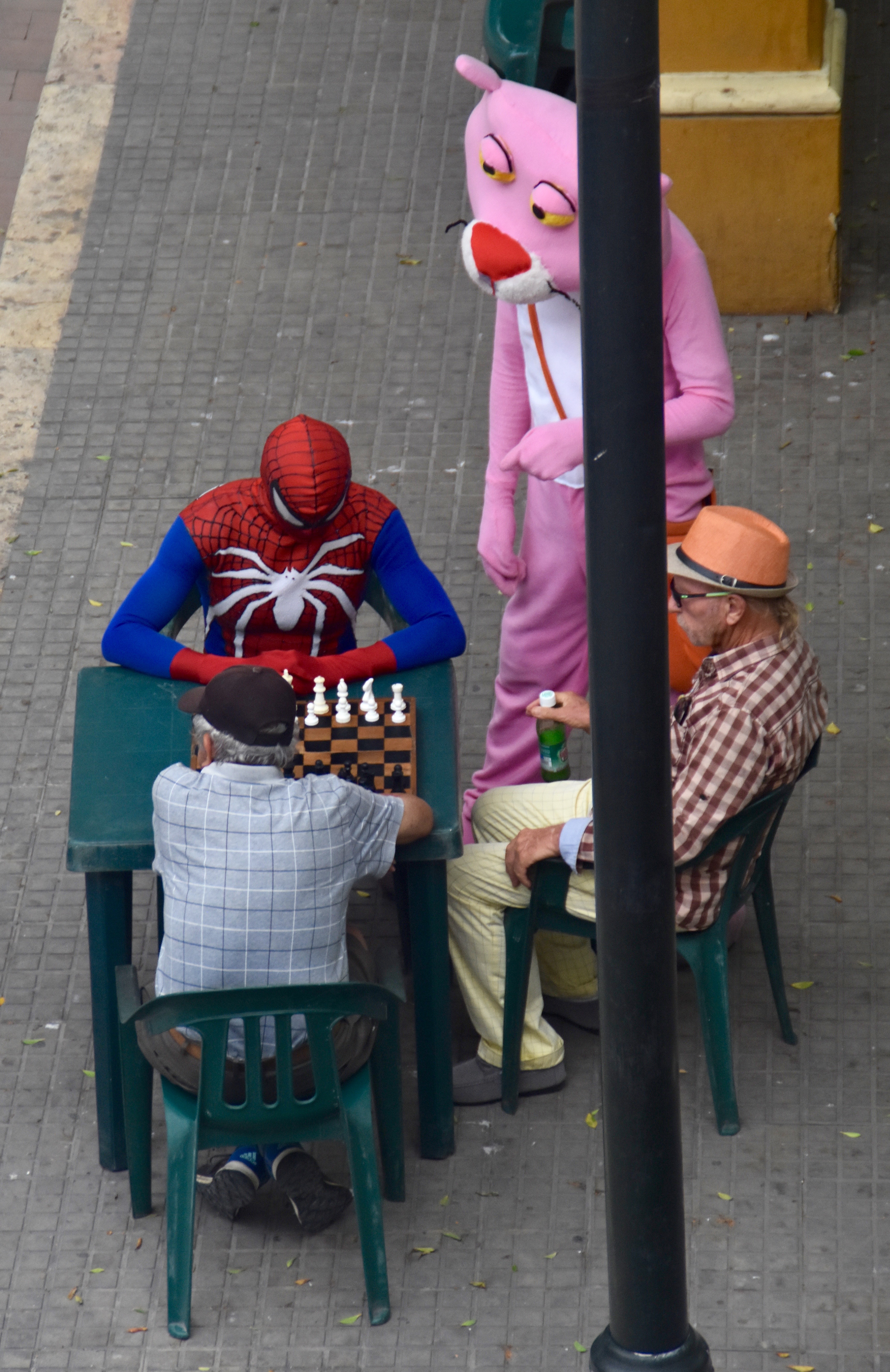
Every street has a nice ceramic marker with the city’s coat-of-arms, a practice borrowed from the home country.
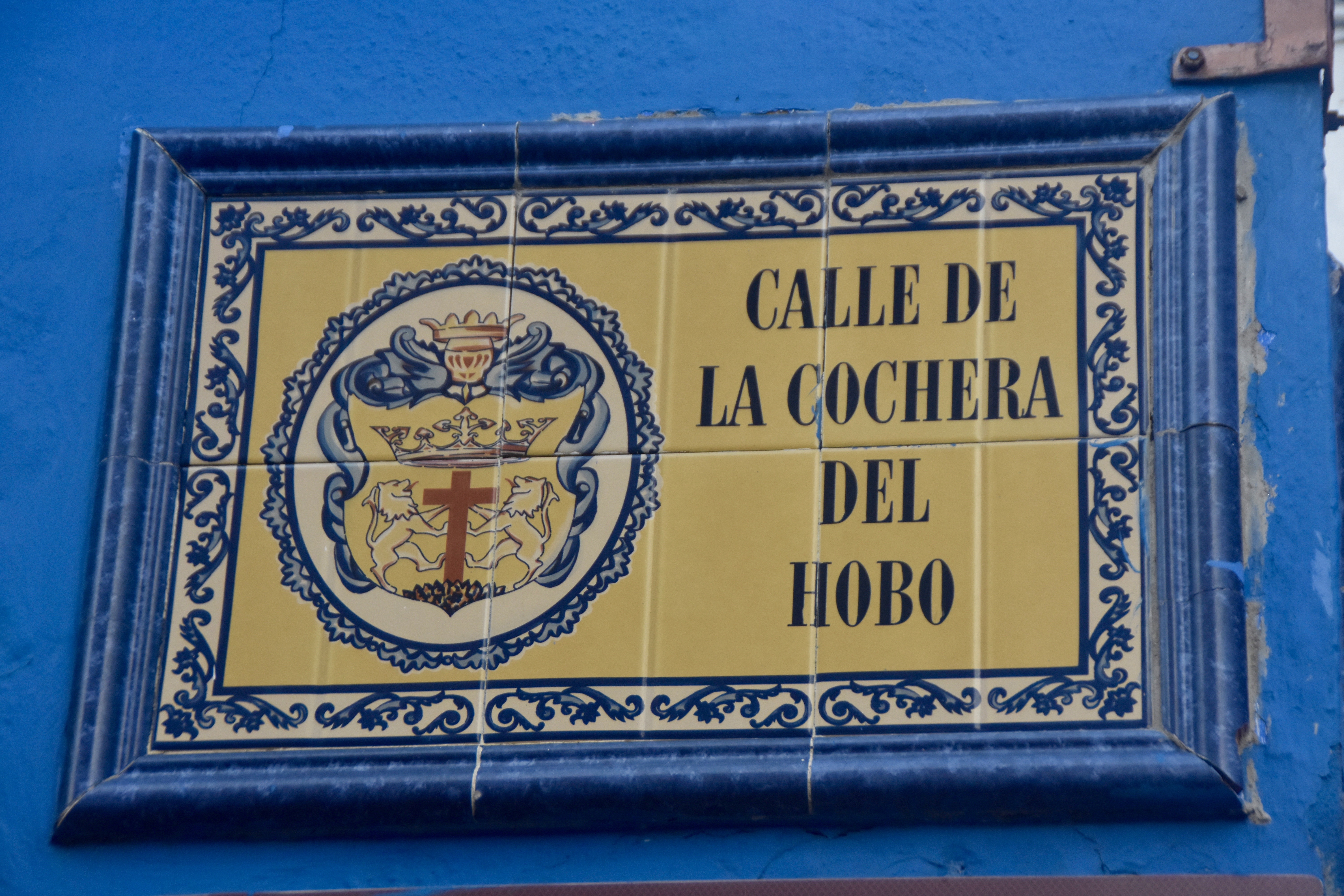
And the most photographed pub sign in Colombia.
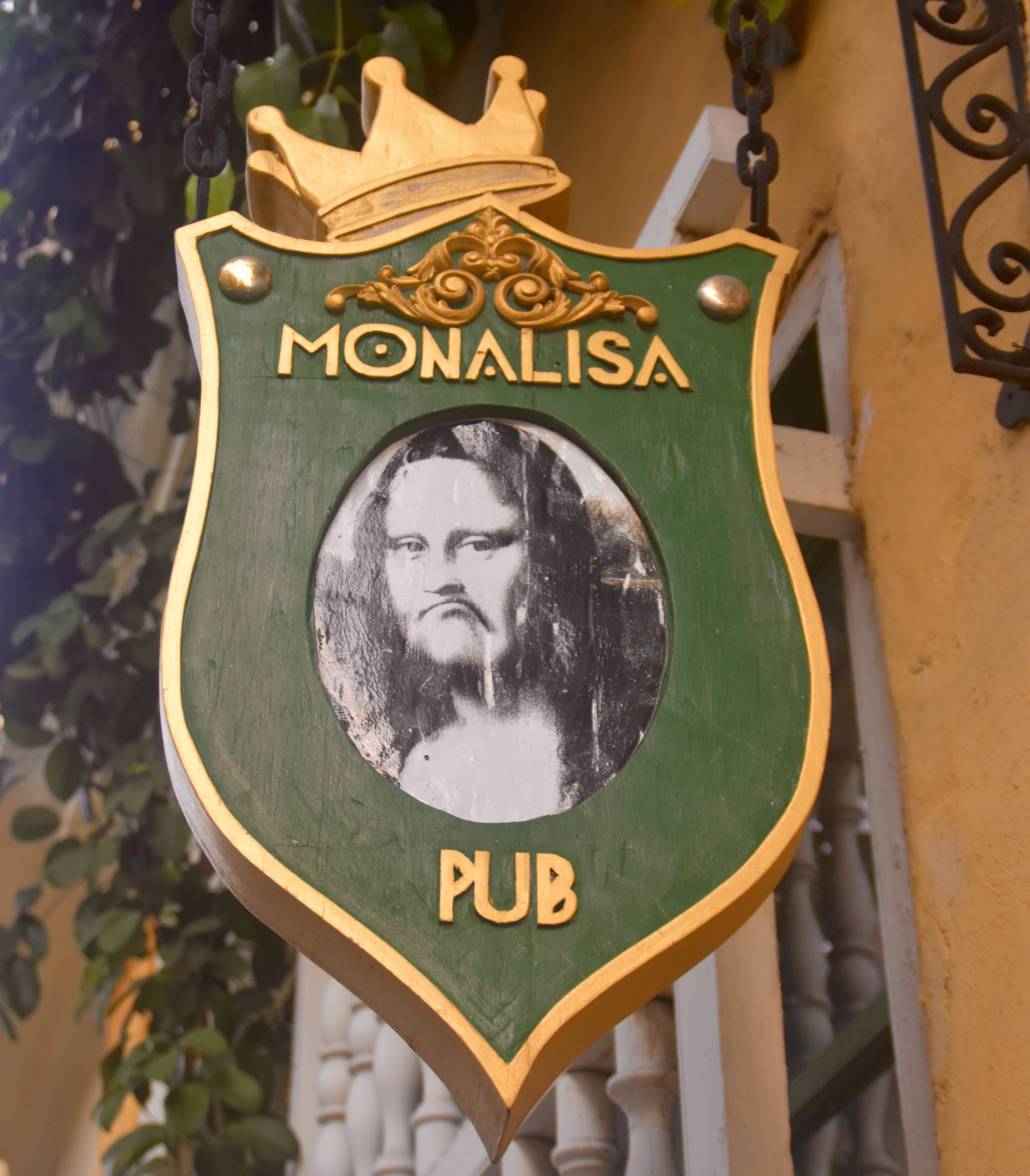
Many houses have interesting door knockers with iguanas being the most common, but I also saw owls, toros and other animals.
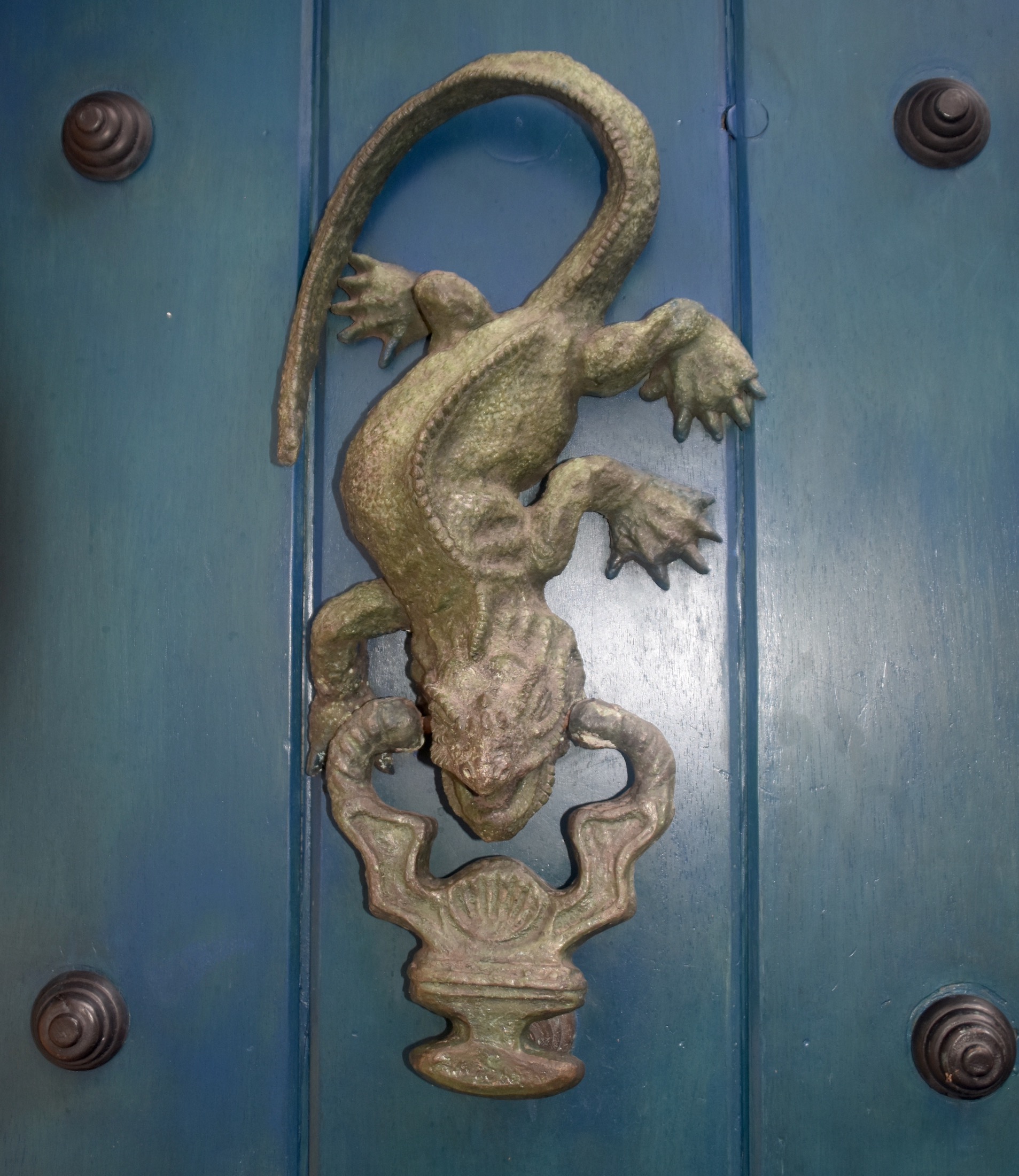
And then there’s the food. Cartagena not surprisingly has great seafood, but I saw restaurants catering to to just about every taste and budget. Our favourite was just down the street from the Bantu Hotel where we were staying. La Mulata is popular with both locals and tourists. It’s informal, reasonably priced and the food is really good.

So was this Yerba Buena, a chilled version of bergamot mint tea, which was probably the tastiest drink we had in Columbia.
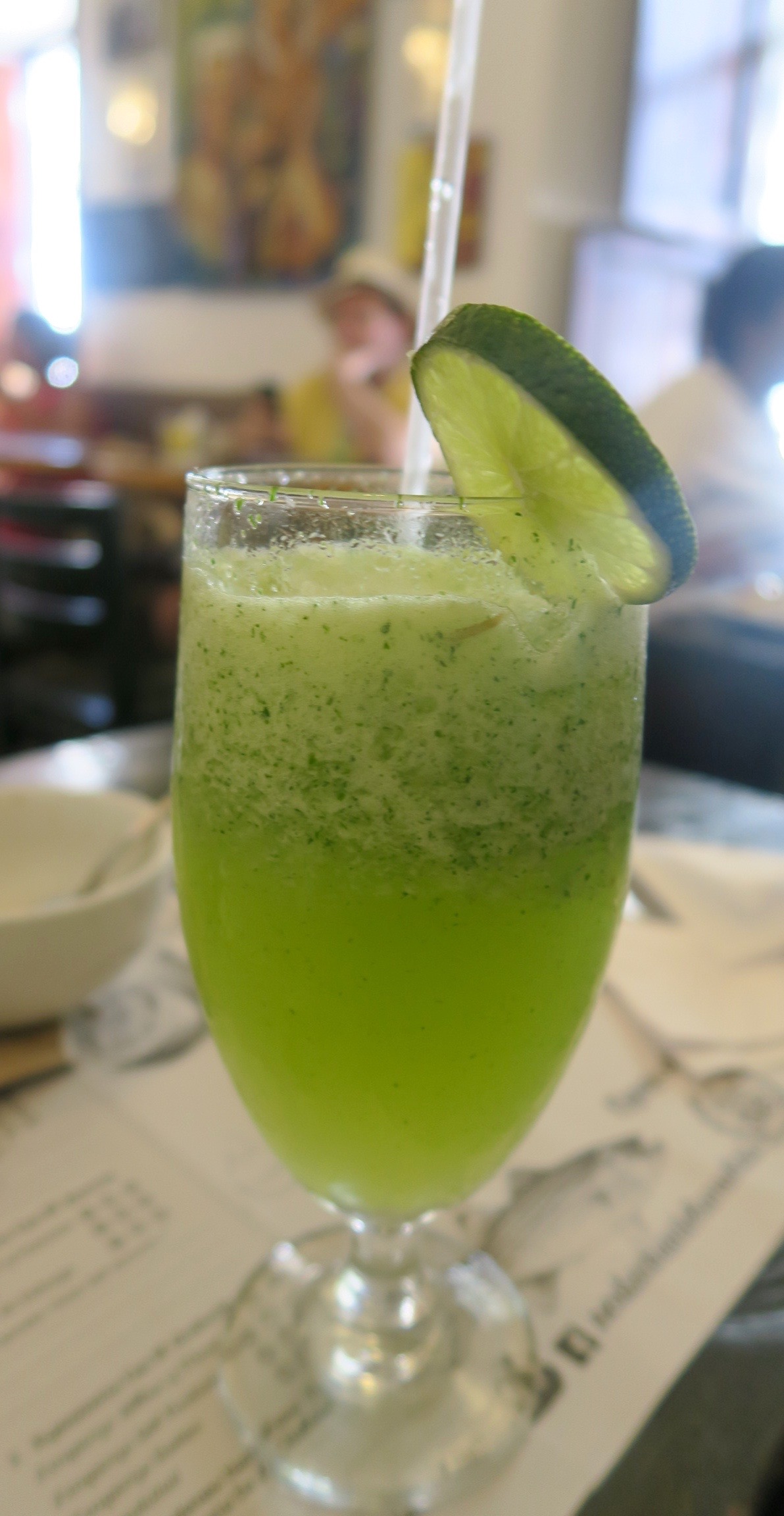
La Mulata has a definite Caribbean flavour to its modest menu. This shrimp, rice and plantain dish is as simple as they come and delicious.
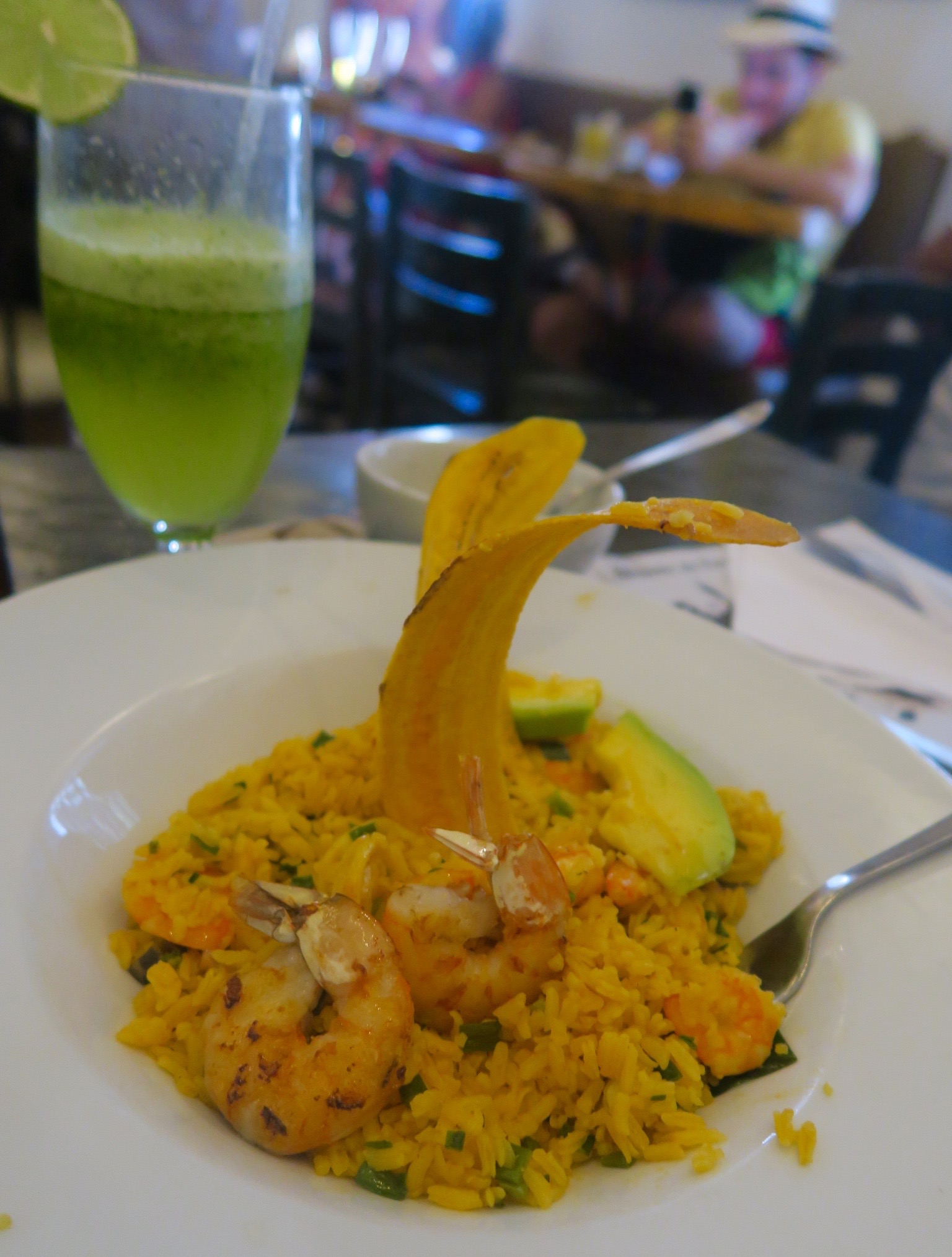
Each entry comes accompanied by a bowl of fish soup.
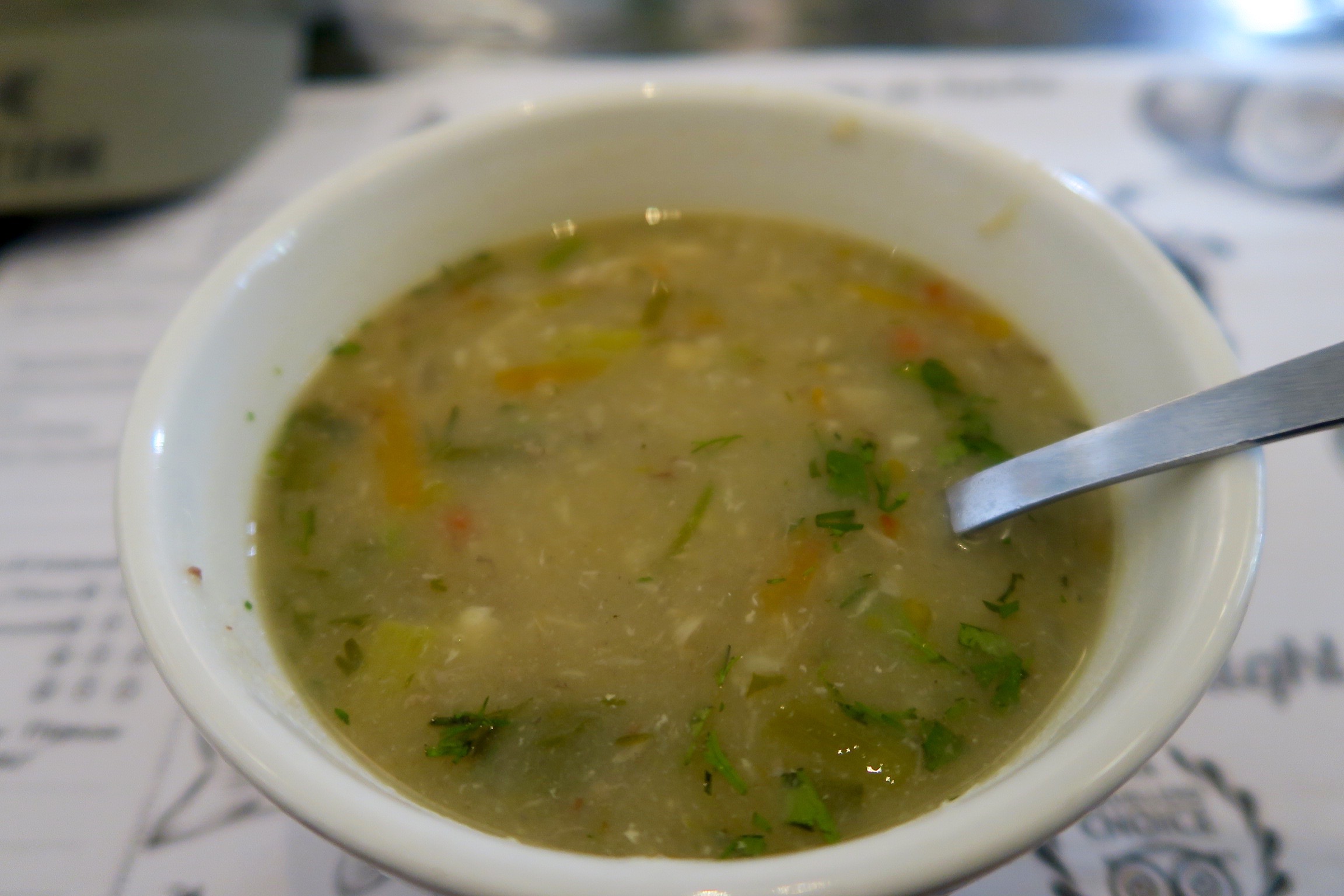
More upscale was El Santisimo, where I really loved this unique looking octopus ceviche.
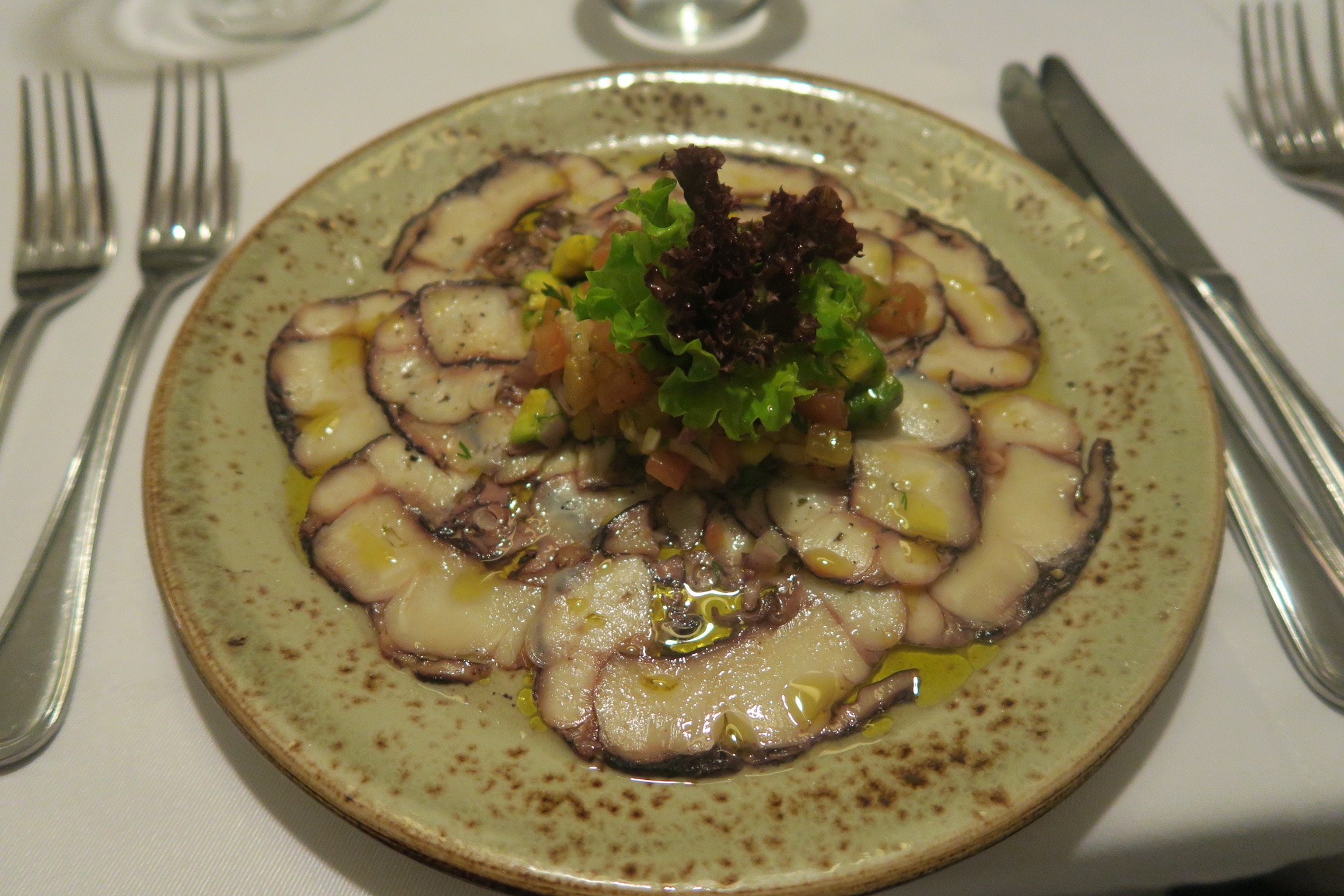
An interesting take on shrimp cocktail.
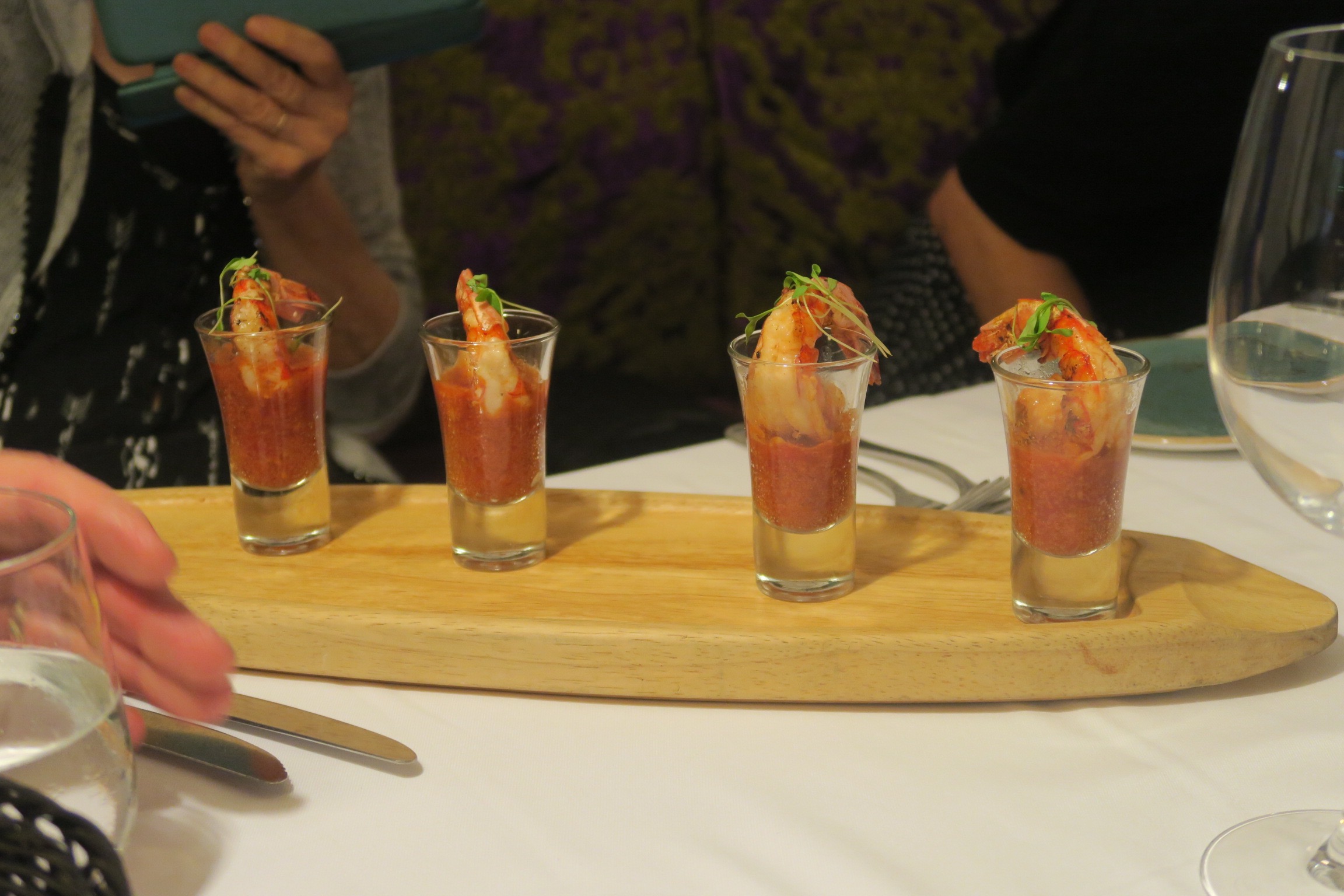
And the signature dish of fish cooked in banana leaf.
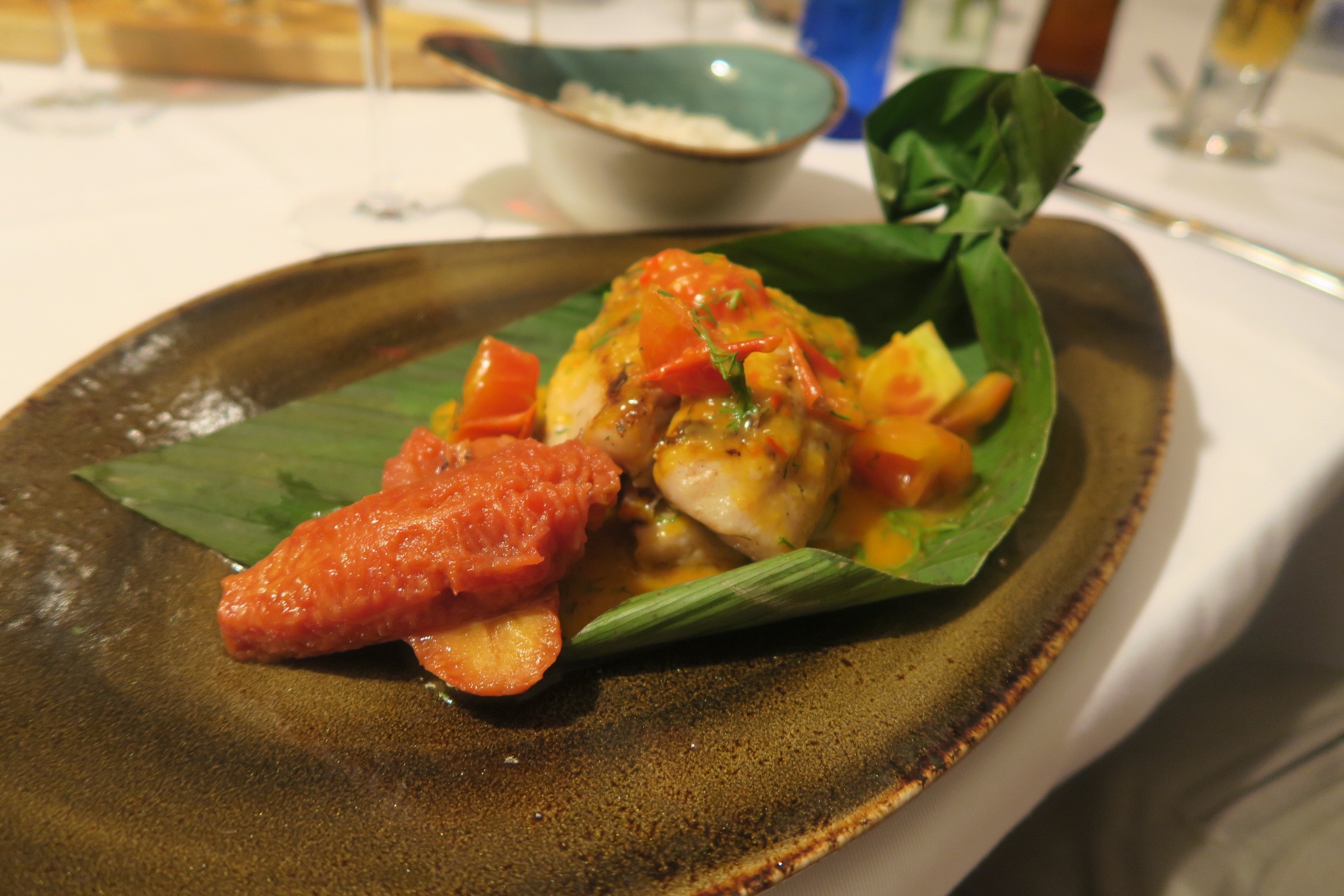
Desserts tended to be an afterthought at most Colombian restaurants, but not El Santisimo. I can’t resist profiteroles and these were as good as any I’ve ever had.
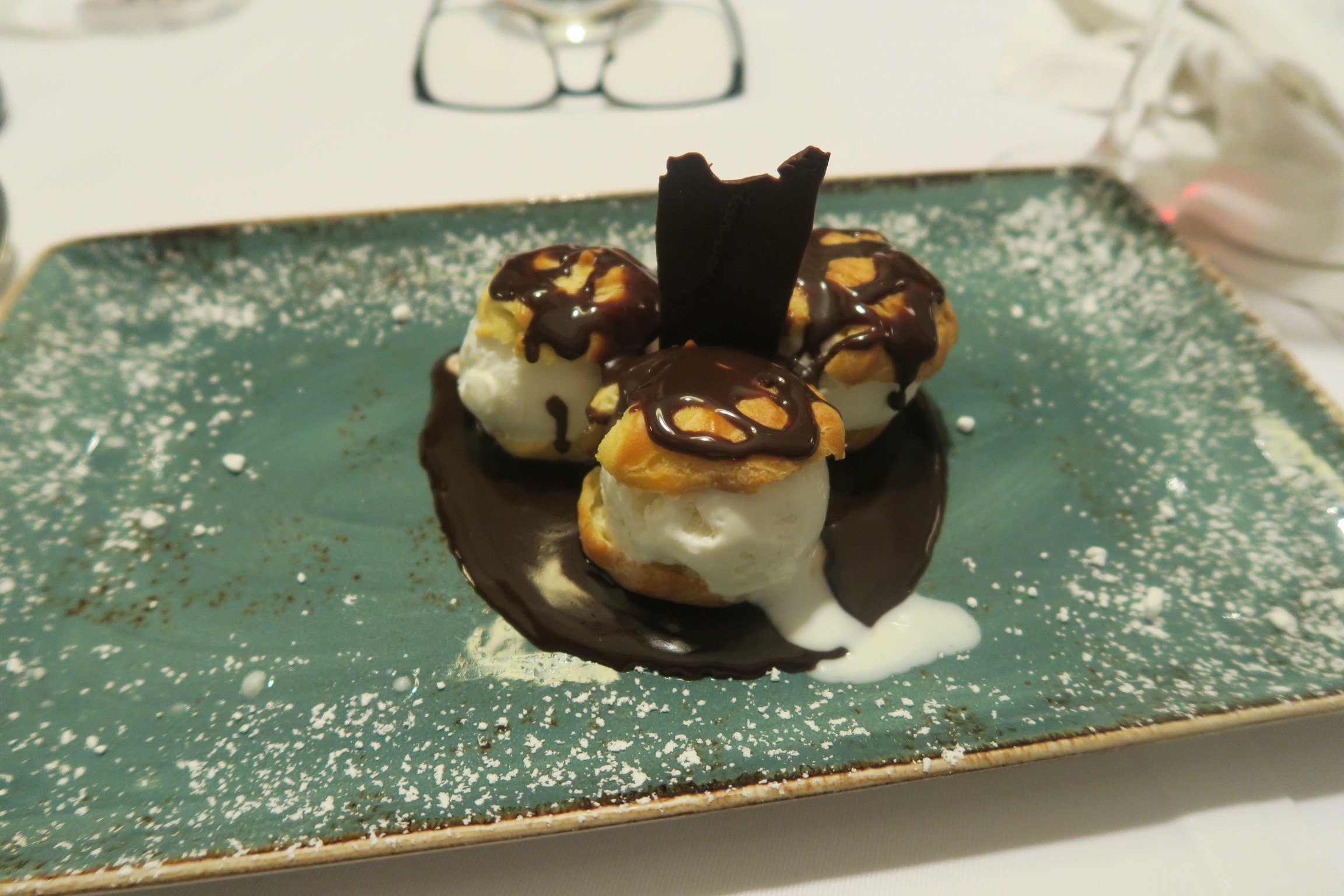
Alison said the same thing about this coconut pie.
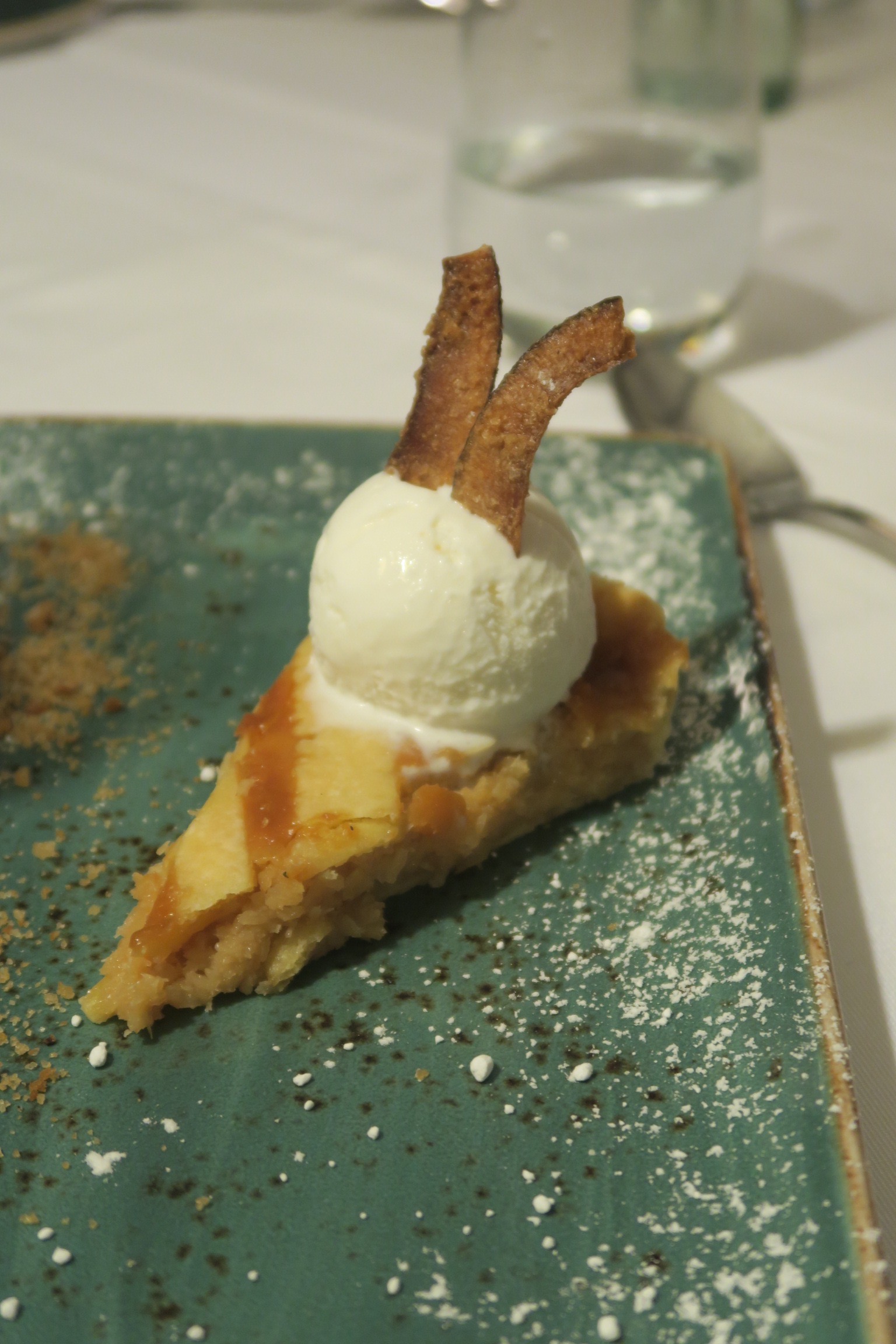
At Lobo de Mar it was amazing ox tail sandwiches that stole the show.
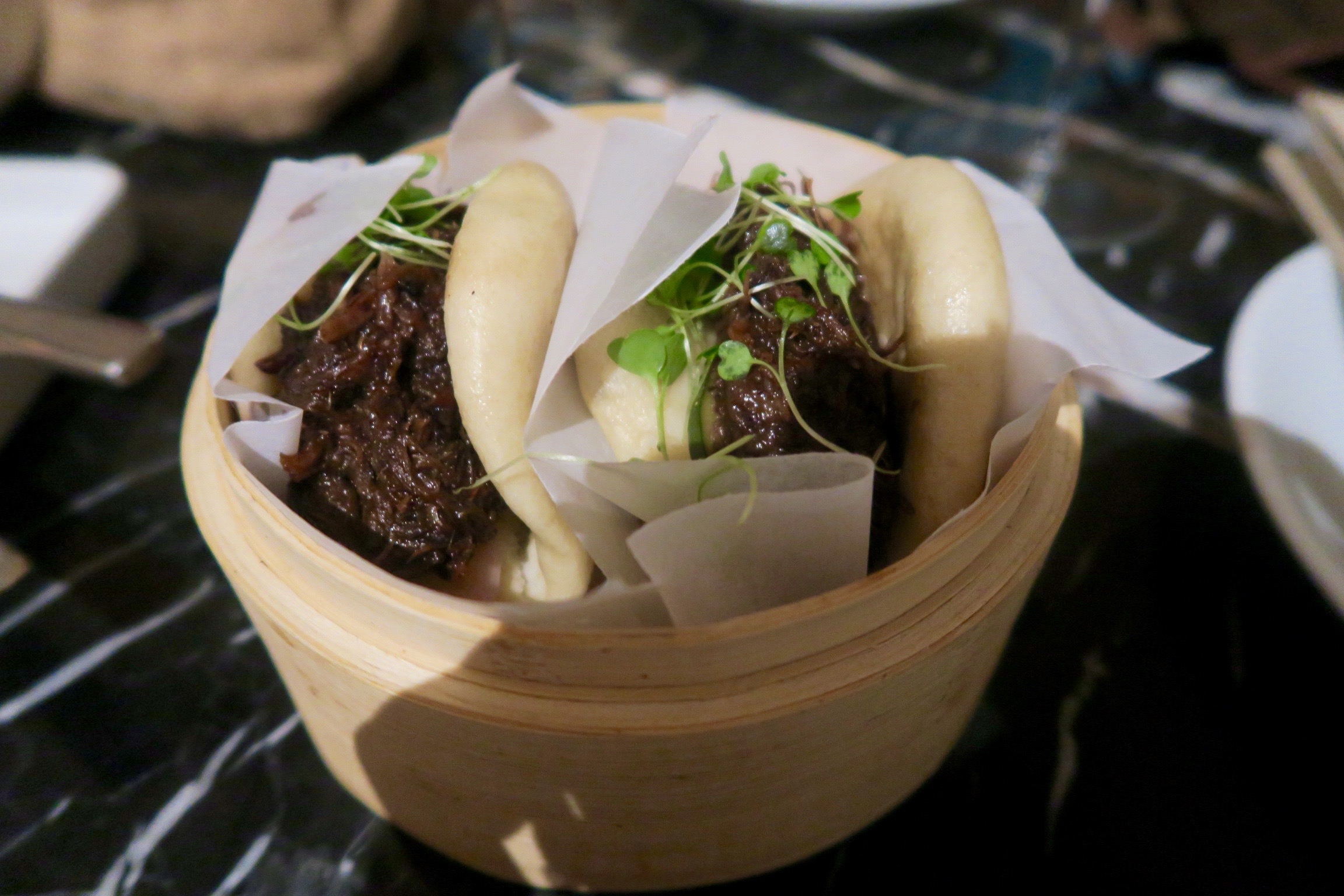
Add to this the great breakfasts we had each morning at the Bantu and I have to give Andrés Fernandéz, our Adventures Abroad tour leader credit for picking out some pretty fine places to eat.
So that’s my list of the intangibles which I think make Cartagena such a wonderful city. Oh, I promised to tell you how to get ride of a mime.
We were returning to our hotel as a group from the plaza in front of San Pedro Claver when this little, 60ish man in ghastly blue lamé pants started following us. It took me a while to realize he was a mime and was imitating to a tee the walks and nuances of each member of our group, including getting Tony’s limp down pat. I was hoping he would just go away, but he didn’t and finally gestured with his hands that he wanted money. I pretended I didn’t understand and eventually he spoke, asking for money, a little too demandingly for me considering we hadn’t ask him to make fun of us, particularly Tony. I pounced on that and said, “I thought you were a mime?” This seemed to discombobulate him and he turned around looking for his next targets. So the secret to breaking the spell of a mime is to trick them into speaking
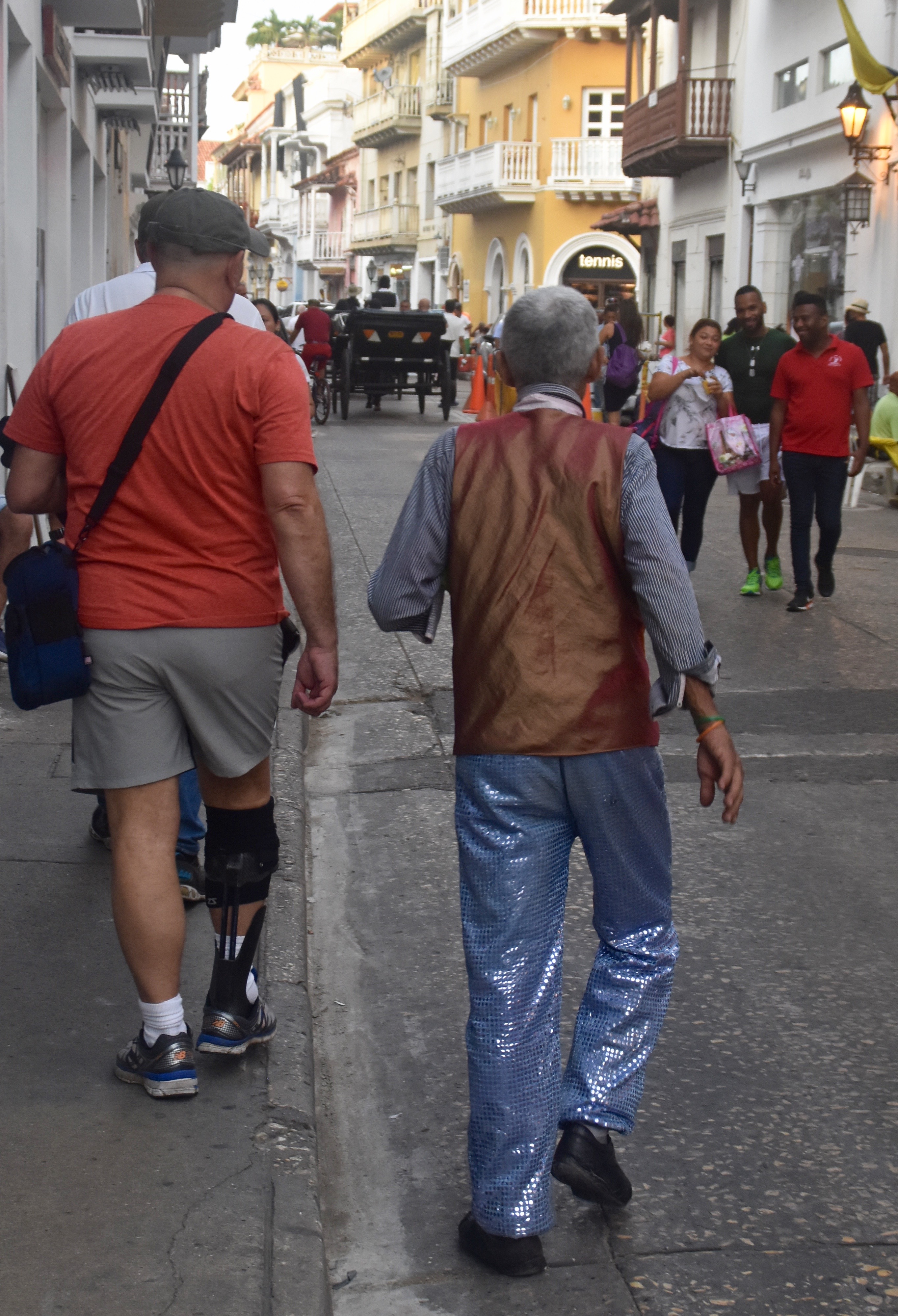
This is my final post from Colombia and I hope you have enjoyed the series. I’ll end with this photo which shows exactly how Alison and I felt about our trip to Colombia and the city of Cartagena in particular. Ordinarily you couldn’t pay me to get into a caleche, but somehow it just seems right here.
